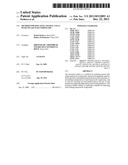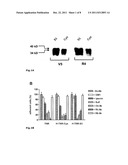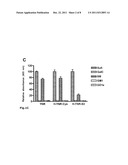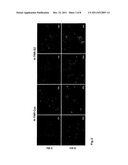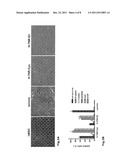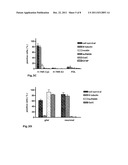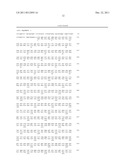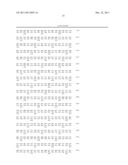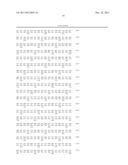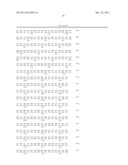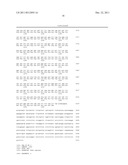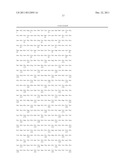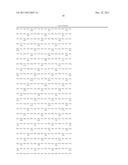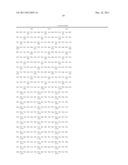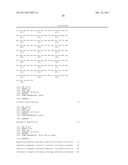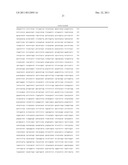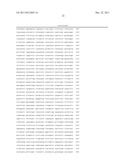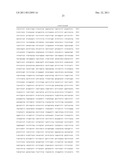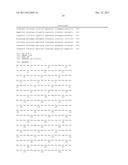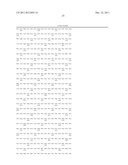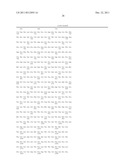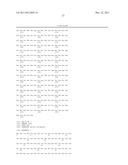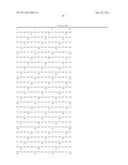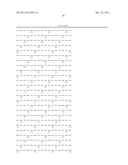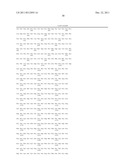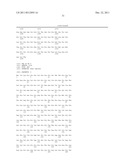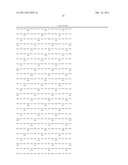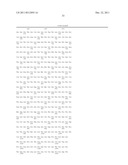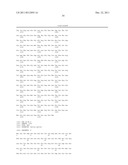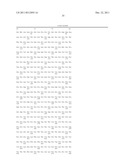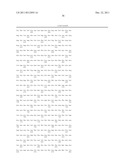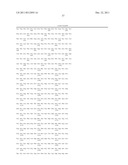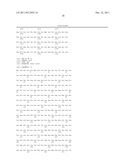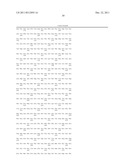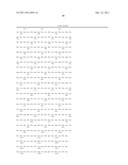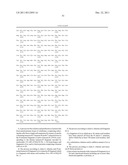Patent application title: METHOD FOR ISOLATING NEURAL CELLS WITH TENASCIN-R COMPOUNDS
Inventors:
Penka Pesheva (Bonn, DE)
Rainer Probstmeier (Bonn, DE)
Assignees:
RHEINISCHE FRIEDRICH-WILHELMS UNIVERSITÄT BONN
IPC8 Class: AA61K3817FI
USPC Class:
514 177
Class name: Designated organic active ingredient containing (doai) peptide (e.g., protein, etc.) containing doai nervous system (e.g., central nervous system (cns), etc.) affecting
Publication date: 2011-12-22
Patent application number: 20110312893
Abstract:
The invention relates to a method for isolating neural cells using
tenascin-R compounds, tenascin-R fragments particularly suited for said
method and tenascin-R fusion proteins, to recombinant preparation of said
tenascin-R compounds, and to a kit for carrying out said method and to
the use of said method for preparing high-purity neural cell populations.
The invention further relates to antibodies suitable for detecting and
isolating tenascin-R compounds.Claims:
1. A process for the isolation and purification of neural cells from
neural primary tissue of vertebrates, comprising selecting the cells from
a single cell suspension by means of a probe containing tenascin-R
("tenascin-R probe") selected from (a) the N-terminal fragment of native
tenascin-R (TN-R) corresponding to the human tenascin-R fragment encoded
by nucleotides 151-648 of SEQ ID No. 1, (b) homologues and fragments of
(a), and (c) fusion proteins comprising a domain with (a) or (b).
2. The process according to claim 1, wherein said N-terminal tenascin-R fragment (a) is a tenascin-R fragment which is a fragment with amino acid residues 24 to 189 of SEQ ID No. 2.
3. The process according to claim 1, wherein said fragment (b) is (i) a fragment of (a) in which up to 10, amino acid residues have been cleaved off from the N and/or C terminus, and/or which has at least 150 amino acid residues; and/or (ii) a substitution, deletion and/or addition mutant of (a) or (b).
4. The process according to claim 1, wherein said tenascin-R fusion protein (c) (i) has at least one domain with a tenascin-R fragment (a) or (b) and a functional domain including one or more other functional peptides or proteins, or (ii) is composed of two or more, functional tenascin-R fragments (a) or (b).
5. The process according to claim 1, wherein (i) said TN-R fragment originates from vertebrates; and/or (ii) said tenascin-R probe contains further functional peptide or protein sequences and/or is coupled to a support; and/or (iii) said tenascin-R fragment is a peptide having the sequence of amino acid residues 24 to 189 of SEQ ID No. 2.
6. The process according to claim 1, wherein (i) said process is adapted for the isolation and purification of glial cells; and/or (ii) said process is adapted for the transdifferentiation of adult human mesenchymal stem cells into neuronal or oligodendroglial cells; and/or (ii) said vertebrate primary tissue originates from lower and higher vertebrates; and/or (iii) the isolation of the cells is effected by selective substrate adhesion to the tenascin-R probe and/or in a single purification step.
7. The process according to claim 1, wherein said single cell suspension (i) is prepared from embryonic, fetal, early or late postnatal and/or adult tissues; and/or (ii) is prepared from tissue from different regions of the nerve system; and/or (iii) contains cells of one or more differentiation stages.
8. The process according to claim 1, wherein (i) said tenascin-R probe is bound to a support material by non-covalent interactions or by another adequate coupling technique which does not change the specificity of the tenascin-R probe; and/or (ii) said single cell suspension is contacted with said tenascin-R probe so that tenascin-R-binding cells present in said single cell suspension become bound to said probe; and/or (iii) isolation of these cells from the cell culture is effected by specific binding of neural stem cells from said single cell suspension to said tenascin-R probe, the unbound cells are removed, and optionally the cells bound to the support material through said tenascin-R probe are subsequently detached from the support material by trypsinization, incubation with a solution of proteolytic and collagenolytic enzymes (ACCUTASE®) or another adequate method; and/or (iv) the bound cells are detected by immunological methods; and/or (v) the process is effected in vitro.
9. The process according to claim 1, which is adapted (i) for obtaining neural cells, for growing differentiated cells, in neurobiological and cell-physiological examinations, in biological and clinical research and for diagnostic and therapeutic processes in vitro and in vivo; and/or (ii) for the detection of neurodegenerative diseases.
10. A tenascin-R fragment or tenascin-R fusion protein as defined in claim 1.
11. A DNA which codes for a tenascin-R fragment or tenascin-R fusion protein according to claim 10.
12. A vector which comprises a DNA according to claim 11.
13. A host organism transformed/transfected with a vector according to claim 12.
14. A process for preparing a tenascin-R fragment or TN-R fusion protein, comprising the step of culturing said host organism according to claim 13.
15. An antibody obtainable by the immunization of a suitable host organism with a tenascin-R fragment according to claim 10.
16. The antibody according to claim 15, which (i) is specific for a tenascin-R fragment; and/or (ii) is obtainable by immunization with tenascin-R fragments from at least two different species, and/or which binds to the N-terminal tenascin-R of at least two different species; and/or (iii) is monoclonal.
17. A cell line or hybridoma cell line which produces a monoclonal antibody according to claim 15.
18. Method of using the antibody according to claim 15 (i) for the immunochemical detection of TN-R; (ii) for inhibiting the effect of TN-R; (iii) for influencing the neural development; and (iv) for preparing medicaments for the therapy and prophylaxis of traumatic nerve lesions and medicaments for selectively influencing the neural development.
19. A kit for the isolation and purification of neural cells, according to the process according to claim 1, especially containing (i) a tenascin-R probe; and/or (ii) a vector which codes for the tenascin-R probe defined in (i); and/or (iii) a stock culture of a cell line which is adapted for expressing said tenascin-R probe.
20. The kit according to claim 19, wherein (i) said probe is bound to a support material; and/or (ii) the kit further comprises tenascin-R antibodies; and/or (iii) the kit further comprises enzymatic solutions for cell dissociation, buffers and/or culture media.
21. Method of using a tenascin-R fragment or tenascin-R fusion protein as defined in claim 10 for obtaining neural cells, for growing differentiated cells, in neurobiological and cell-physiological examinations, in biological and clinical research and for diagnostic and therapeutic processes in vitro and in vivo.
22. A process for preparing oligodendrocytes from isolated stem cells in vitro by incubating the stem cells in the presence of a tenascin-R fragment or tenascin-R fusion protein as defined in claim 10.
23. The process according to claim 22, wherein said isolated stem cells are neural or non-neural stem cells which have the potential for sulfatide expression.
24. A process for cell therapy or for the therapy of neurodegenerative diseases accompanied by a loss of oligodendrocytes or myelin, comprising the step of administering a tenascin-R fragment or tenascin-R fusion protein as defined in claim 10 to a human or animal patient.
25. A process for the therapy and prophylaxis of traumatic nerve lesions or for selectively influencing the neural development, comprising the step of administering a pharmacologically sufficient amount of the antibody according to claim 15 to a human or animal patient in need of such treatment.
Description:
[0001] The invention relates to a process for isolating neural cells using
tenascin-R compounds, tenascin-R fragments and tenascin-R fusion proteins
that are particularly suitable for such process, the recombinant
preparation of such tenascin-R compounds, and a kit for performing this
process, and the use of the process for preparing highly pure neural cell
populations. The invention further relates to antibodies suitable for the
detection and isolation of tenascin-R compounds.
BACKGROUND OF THE INVENTION
[0002] When cells come into contact with the surrounding extracellular environment, then cell may show a wide variety of responses that may range from rejection and avoidance of the environment on the one hand to stable cell adhesion on the other. The interplay between components of the extracellular environment, the extracellular matrix, on the one hand and receptors for such components present on the cell surface on the other hand represents the basis of many processes of development biology, which are characterized for a cell, inter alia, by proliferation, migration or differentiation behavior. Such cellular behavior leads to pattern formation on the organism level, or to new formation as a result of injury on the tissue or organ level (Boudreau, N.J., Jones, P. L., Biochem. J. 339: 481-488 (1999); Sobeih, M. M., Corfas, G., Int. J. Dev. Neurosci. 148: 971-84 (2002); Schmid, R. S., Anton, E. S., Cereb. Cortex. 13: 219-24 (2003)). In the central nervous system (CNS), the regulated expression of extracellular matrix components, such as chondroitin sulfate proteoglycans or proteins of the tenascin family, correlates with biological processes which include both the adhesion and migration of neurons, the navigation of axons, synapse formation and plasticity, the action of growth factors and cytokines as well as the survival of neurons and the structural organization of the extracellular matrix (Dow, K. E., Wang, W., Cell Mol. Life Sci. 54: 567-81 (1998); Wright, J. W. et al., Peptides 23: 221-46 (2002); Grimpe, B., Silver, J., Prog. Brain Res. 137: 333-49 (2002); Bosman, F. T., Stamenkovic, I., J. Pathol. 200: 423-8 (2003)).
[0003] Tenascin-R (TN-R) (formerly referred to as J1-160/180, janusin or restrictin) is a member of the tenascin family of extracellular matrix proteins that occurs exclusively in the CNS of vertebrates, where it is expressed by oligodendrocytes and some groups of neurons, i.e., motoneurons and interneurons, during later stages of the development and in the adult state (Pesheva, P., Probstmeier, R., Prog. Neurobiol. 61: 465-93 (2000); Scherberich, A. et al., J. Cell Sci. 117: 571-81 (2004)). The protein occurs in two molecular forms having molecular weights of 160 kD (TN-R 160) or 180 kD (TN-R 180). TN-R is found in the tissue primarily in association with oligodendrocytes, myelinized axons, perineuronal networks of motoneurons and interneurons, and in regions rich in dendrites and synapses.
[0004] TN-R is composed of four different domain structures. The N terminus, whose sequence occurs only in tenascin proteins, contains a cysteine-rich segment (Cys-rich) and is followed by four and a half EGF-like segments (EGF-like) as well as 9 fibronectin type III (FN III) like domains (of which the 6th domain may be alternatively spliced). The C terminus of the TN-R protein is formed by a globular fibrinogen-like domain (FNG). Single TN-R polypeptide chains are connected through disulfide bridges at their N termini and thus form homo-trimers (TN-R 180) or dimers (TN-R 160), the latter being formed by the proteolytic cleavage of TN-R 180 near the N terminus (Woodworth, A. et al., J. Biol. Chem. 279: 10413-21 (2004)).
[0005] The functional range of TN-R comprises the molecular control of neural cell adhesion, migration and differentiation (from the axon navigation of neurons forming processes to the maturation of myelin-forming oligodendrocytes) during normal development-biological processes as well as regenerative processes upon injury in the adult brain (Pesheva, P., Probstmeier, R., Prog. Neurobiol. 61: 465-93 (2000); Chiquet-Ehrismann, R., Int. J. Biochem. Cell. Biol. 36: 986-90 (2004)). Inter alia, TN-R acts as an adhesive or anti-adhesive molecule, as a differentiation factor for oligodendrocytes, or as a "stop molecule" for growing axons. These properties depend on the corresponding general conditions: the respective cell type, the presence of cellular receptors and signal cascades, the distribution in space and the posttranslational modification of the TN-R glycoprotein. Some of the cellular receptors of TN-R that have been identified (F3/F11, disialogangliosides, sulfatides) induce different cellular mechanisms of action which are important on the one hand in the pattern formation during ontogenesis and on the other hand in regenerative processes (Angelov, D. et al., J. Neurosci. 18: 6218-29 (1998); Probstmeier, R. et al., J. Neurosci. Res. 60: 21-36 (2000); Montag-Sallaz, M., Montag, D., Genes Brain Behav. 2: 20-31 (2003); Saghatelyan, A. et al., Nat. Neurosci. 7: 347-56 (2004); Brenneke, F. et al., Epilepsy Res. 58: 133-43 (2004)). The two essential effects of TN-R on the behavior of neural cells are the inhibition of cell adhesion and neurite growth on the one hand, and the promotion of oligodendrocyte adhesion and differentiation on the other. The latter is mediated by sulfatides and ultimately causes oligodendrocyte migration and myelinization/remyelinization. The former can occur either substrate-independently (mediated by F3/F11 and other, as yet unknown factors) or substrate/integrin-dependently (mediated by fibronectin and GD2/GD3). The inhibitory effect of TN-R ultimately has an influence on the neural cell migration, the space-coordinated axon growth and synaptogenesis, or it contributes to the prevention of axon regeneration and the adhesion of activated microglia in a TN-R-rich environment under injury conditions.
[0006] Some neural receptors and intracellular signal pathways that mediate the effect of TN-R in neuronal and glial cells are known, and molecular components involved in the expression of TN-R by oligodendrocytes and motoneurons could also be identified (Table 1; Pesheva, P. et al., Prog. Brain Res. 132: 103-14 (2001)).
TABLE-US-00001 TABLE 1 Cellular receptors and ligands of the extracellular matrix identified for TN-R. Tenascin-R Ligands of the Tenascin-R Cellular binding extracellular binding receptors domain matrix domain F3/F11 EGF-L, FN2-3 Fibronectin CS GAG, unknown β2 subunit of FN1-2, FN6-8 Collagens unknown Na channels Neurofascin FN2-5 Tenascin-C CS GAG, Ca2+-dependent CALEB FNG Tenascin-R unknown, cation2+-dependent MAG EGF-L, FNG Lecticane FN3-5, Ca2+-dependent Sulfatides unknown Phosphacane EGF-L, Ca2+-dependent Gangliosides unknown In the right-hand half of the Table, the domains of TN-R relevant for the respective interaction are stated; CS GAG: chondroitin sulfate glycosaminoglycans; EGF-L: EGF-like segments and cystein-rich segment.
[0007] As TN-R is an extracellular matrix protein constituted of several domains, an attribution of the distinct biological functions to distinct domain regions and/or distinct glycostructures of TN-R suggests itself. Similar to the other known TN-R proteins, the human TN-R protein is composed of different distinct domains (Carnemolla et al., 1996). Starting with a cysteine-rich region at the N terminus, followed by 4.5 EGF-like domains and 9 FNIII-like domains (of which the 6th domain can be alternatively spliced), the molecule ends at the C terminus with a fibrinogen-like domain. The published human TN-R mRNA sequence comprises 4716 bases with 9 FNIII-like domains. Of these, the coding region comprises the segment between bases 82 to 4158, the signal peptide (for the secretion of the TN-R protein) comprises the region of bases 82 to 150 (SEQ ID No. 2).
[0008] It is known that TN-R proteins purified from adult rodent brain promote the adhesion and process formation of O4/sulfatide-positive oligodendrocytes isolated from early postnatal brain (Pesheva, P. et al., J. Neurosci. 17: 4642-51 (1997)).
[0009] These processes are mediated by sulfatides, a group of glycolipids occurring in the cell membrane of oligodendrocytes. An important consequence of the interaction of TN-R with sulfatide-expressing oligodendrocytes is a stimulation of the maturation of these cells; i.e., the increased expression of myelin-specific proteins and glycolipids, which suggests a sulfatide-mediated mode of action of the differentiation potential of TN-R on oligodendrocytes (Pesheva, P. et al., J. Neurosci. 17: 4642-51 (1997)).
[0010] EP 0 759 987, U.S. Pat. No. 5,635,360, U.S. Pat. No. 5,681,931 and U.S. Pat. No. 5,591,583 describe human TN-R and its immunological detection using antibodies directed against a protein fragment that corresponds to the nucleotides 2686-3165 of the cDNA sequence and thus to the FN III domains 6 and 7 of human TN-R.
[0011] The earliest stages of developing glia cells in mammals are found in ventral regions of the neural tube in the spinal cord, and in ventricular zones of the fore-brain in the brain. In these regions, first precursor cells of oligodendrocytes characterized by a simple morphology and the expression of the disialogan-glioside GD3 and/or of O4 antigens proliferate and migrate in the following time into regions of the later formed white substance (Miller, R. H. Prog. Neurobiol. 67: 451-67 (2002); Noble, M. et al., Dev. Biol. 265: 33-52 (2004); Liu, Y. Rao, M. S., Biol. Cell. 96: 279-90 (2004)). There, the cells become postmitotic and differentiate into mature oligodendrocytes with a complex morphology. This maturation process correlates with the expression of myelin-specific lipids (sulfatides and galactocerebrosides) and proteins (MBP, MAG and PLP). The formation, the survival and the differentiation of oligodendrocytes in myelin-forming cells are regulated through various growth factors (bFGF, PDGF, CNTF, IGF-1, NT-3), hormones and extracellular matrix molecules (thyroid hormones, retinolic acid, TN-R) (Dubois-Dalcq, M., Murray, K., Pathol. Biol. (Paris) 48: 80-6 (2000); Kagawa, T. et al., Microsc. Res. Tech. 52: 740-5 (2001); Noble, M. et al., Dev. Neurosci. 25: 217-33 (2003)).
[0012] Since especially for glial cells (such as oligodendrocytes and neural stem cells) no adequate model systems in the form of cell lines exist, relatively time-consuming and low-efficient enrichment processes of primary cells have had to be recurred to to date in their recovery both in basic research and within the scope of potential diagnostic/therapeutic fields of application. In addition, these processes often enable only the preparation of enriched mixed cell populations. The previous processes for isolating defined cell populations utilize different techniques, such as density gradient centrifugations or immunological processes (Fluorescence-activated cell sorting, biomagnetic cell sorting, antibody- and complement- mediated cell killing, antibody panning) (Luxembourg, A. T. et al., Nat. Biotechnol. 16: 281-5 (1998); Uchida, N. et al., Proc. Natl. Acad. Sci. 97: 14720-5 (2000); Nistri, S. et al., Biol. Proced. Online 4: 32-37 (2002); Nunes, M. C. et al., Nat. Med. 9: 439-47 (2003); Vroemen, M., Weidner, N., J. Neurosci. Methods 124: 135-43 (2003)). Such methods are not very efficient and result in an incomplete enrichment (by density gradient centrifugations, for example, enrichments of distinct cell populations are only possible), or they are time-intensive and/or accompanied by high cell losses (as in immunological processes). This applies, in particular, to oligodendrocytes which to date have been obtained by several weeks of cultivation of mixed glial cultures (McCarthy, K. D., DeVellis, J., J. Cell Biol. 85: 890-902 (1980); Kramer, E. M. et al., J. Biol. Chem. 274: 29042-9 (1999); Testai, F. D. et al., J. Neurosci. Res. 75: 66-74 (2004)) or by several selection steps by means of fluorescence-activated/biomagnetic cell sorting or antibody panning (Scarlato, M. et al., J. Neurosci. Res. 59: 430-5 (2000); Tang, D. G. et al., J. Cell Biol. 148: 971-84 (2000); Diers-Fenger, M. et al., Glia 34: 213-28 (2001); Crang, A. J. et al., Eur. J. Neurosci. 20: 1445-60 (2004)).
[0013] WO2006/067094 describes purified TN-R proteins that support the stable adhesion of oligodendrocytes in different stages of maturity and have an anti-adhesive effect on neuronal and microglial cells. This enables the isolation and purification of defined cell populations from neural primary tissue, especially for the direct selective purification of oligodendrocytes from mixed neural cell populations. A process is herein provided that enables the isolation of a highly pure defined cell population, especially an oligodendrocyte population, from primary tissue of neural origin in a single purification step. The purification of the cells is effected by a selection step from a single cell suspension by means of a probe containing tenascin-R comprising tenascin-R compounds selected from native tenascin-R (briefly "TN-R" hereinafter) as well as homologues and fragments thereof and fusion proteins of such compounds. A preferred tenascin-R fragment contains the C terminus of native tenascin-R or a substitution, deletion and/or addition mutant thereof, especially the region encoded by the nucleotides 3439-4155 of SEQ ID No. 1.
[0014] It has now been found that a fragment comprising amino acid residues 24 to 189 of SEQ ID No. 2 of human TN-R or a homologue or fragment thereof, such as the fragment H-TN-R-Cys, which includes amino acid residues 24 to 189 of SEQ ID No. 2, can be applied in a one-step process for the isolation of highly pure glial, especially oligodendroglial, cell populations with similar suitability as the H-TN-R-S3 fragment with amino acid residues 1120 to 1358 of SEQ ID No. 2 as described in WO 2006/067094. In contrast to H-TN-R-S3, the H-TN-R-Cys fragment additionally binds sphingomyelin (a phospholipid occurring in the cell membrane of different cell types and involved in cellular signal mechanisms) and supports the survival and the transdifferentiation of adult human mesenchymal stem cells into neuronal or oligodendroglial cells.
[0015] Thus, the invention relates to:
[0016] (1) a process for the isolation and purification of neural cells from neural primary tissue of vertebrates, comprising the selection of the cells from a single cell suspension by means of a probe containing tenascin-R ("tenascin-R probe"), which includes an N-terminal fragment of native tenascin-R (TN-R) as well as homologues and fragments thereof and fusion proteins of such compounds;
[0017] (2) a preferred embodiment of (1) wherein said tenascin-R fragment is a peptide with the sequence of amino acid residues 24-189 of SEQ ID No. 2 that enables the survival and/or transdifferentiation of adult human mesenchymal stem cells into neuronal or oligodendroglial cells, especially under defined serum-free culturing conditions;
[0018] (3) a tenascin-R fragment or tenascin-R fusion protein as defined above under (1) or (2);
[0019] (4) a DNA which codes for a tenascin-R fragment or TN-R fusion protein according to (3);
[0020] (5) a vector which comprises a DNA according to (4);
[0021] (6) a host organism transformed/transfected with a vector according to (5) and/or having a DNA according to (4);
[0022] (7) a process for preparing a tenascin-R fragment or TN-R fusion protein according to (3), comprising the step of culturing said host organism according to (6);
[0023] (8) an antibody, especially a monoclonal antibody, obtainable by the immunization of a suitable host organism with a tenascin-R fragment according to (3);
[0024] (9) a cell line or hybridoma cell line which produces a monoclonal antibody according to (8);
[0025] (10) a kit for the isolation and purification of neural cells, especially of oligodendrocytes, according to the process of (1) or (2), especially containing
[0026] (i) a tenascin-R probe as defined in (1) or (2); and/or
[0027] (ii) a vector which codes for the tenascin-R probe defined in (i); and/or
[0028] (iii) a stock culture of a cell line which is suitable for expressing said tenascin-R probe as defined in (1) or (2);
[0029] (11) the use of a tenascin-R fragment or tenascin-R fusion protein as defined in (3) for obtaining neural cells, especially oligodendrocytes, for growing differentiated cells, especially neural cells, in neurobiological and cell-physiological examinations, in biological and clinical research and for diagnostic and therapeutic processes in vitro and in vivo, especially for the preparation of a medicament for cell therapy and for the therapy of neurodegenerative diseases accompanied by a loss of oligodendrocytes or myelin, especially multiple sclerosis and periventricular leukomalacia (PVL);
[0030] (12) a process for preparing oligodendrocytes from isolated stem cells in vitro by incubating the stem cells in the presence of a tenascin-R fragment or tenascin-R fusion protein as defined in (3);
[0031] (13) a process for cell therapy or for the therapy of neurodegenerative diseases accompanied by a loss of oligodendrocytes or myelin, especially multiple sclerosis and periventricular leukomalacia (PVL), comprising the step of administering a tenascin-R fragment or tenascin-R fusion protein as defined in (3) to a human or animal patient;
[0032] (14) a process for the therapy and prophylaxis of traumatic nerve lesions or for selectively influencing the neural development, comprising the step of administering a pharmacologically sufficient amount of the antibody according to (8) to a human or animal patient in need of such treatment.
BRIEF DESCRIPTION OF THE FIGURES
[0033] FIG. 1: Characterization of the specificity and functional activity of the mono-clonal antibody R4. A) Western blot analysis of affinity-purified H-TN-R-S3 and H-TN-R-Cys fragments with Tag-specific (V5) and TN-R-specific (R4) monoclonal antibodies. The recombinant fragments H-TN-R-S3 (S3) and H-TN-R-Cys (Cys) purified by nickel-agarose (20 ng/slot) were separated by gel electrophoresis, blotted onto nitrocellulose filters and incubated with V5 or R4 antibodies. Immuno-reactive protein bands were detected by incubation with peroxidase-coupled anti- mouse IgG antibodies. Arrows indicate the molecular weight of H-TN-R-S3 (40 kD) and H-TN-R-Cys (34 kD). B) Influence of polar glycolipids, lysenin (sphingomyelin-binding protein), O4- and TN-R-specific antibodies on TN-R-mediated cell adhesion. TN-R substrates (TN-R, H-TN-R-Cys, H-TN-R-S3) were preincubated in the absence (-GL/Ab) or presence of monosialogangliosides (+GM1), sulfatides (+Sulf) and TN-R-specific antibodies (R4, R6). Erythrocytes were sown in the presence or absence of lysenin (100 μg/ml) and O4 antibodies (+O4 Ab) onto the corresponding substrates. The number of adherent cells after one hour of incubation on untreated TN-R substrates (-GL/Ab) was set at 100% C) Interaction of R4 epitope bearing TN-R/TN-R fragments with polar glycolipids in solid-phase binding assay. Microtitration plates were coated with sulfatides (Sulf), galactocerebrosides (GalC), sphingomyelin (SM) or sialogangliosides (GM1, GD1a; all at 100 pmol/well), and incubated with TN-R or recombinant TN-R fragments (H-TN-R-Cys, H-TN-R-S3) at room temperature for 2 h. The binding of TN-R/TN-R fragments was detected with R6 (for TN-R) or V5 antibody (after 1.5 hours of incubation at RT) with peroxidase-coupled anti-mouse IgG antibodies. The maximum binding to sulfatides was set at 100% for the respective protein.
[0034] FIG. 2: Selection of oligodendrocytes from single cell suspensions (from brain tissue of 2 days old mice) for substrate-bound TN-R fragments (H-TN-R-Cys, H-TN-R-S3). Cells growing on these substrates were cultured for 3 days in serum-free growth medium (3 div, upper pictures) and for another 3 days (6 div, lower pictures) in serum-free differentiation medium. Adherent cells could be identified as oligodendrocytes by means of indirect immunofluorescence staining with sulfatide-specific antibody (O4). 99±1% of the isolated cells were O4-positive. Survey (10×) and detail pictures (20× and 40×) show O4-positive cells on the different substrates after different culturing times.
[0035] FIG. 3: H-TN-R-Cys-mediated neural differentiation of human mesenchymal stem cells (hMSC) from adult bone marrow. Cells growing on the different substrates were stained with antibodies against marker molecules for neurons (βIII tubulin), neural/glial progenitor cells (nestin), oligodendrocytes (sulfatide, GalC) or astrocytes (GFAP) by means of indirect immunofluorescence after the stated culturing times. To determine the cell survival, adherent cells on the different substrates were stained with DAPI at the beginning and end of the culturing period, and the ratio of the corresponding total cell numbers was calculated. A) hMSC (left picture) were cultured on substrate-bound laminin and TN-R fragments (H-TN-R-Cys, H-TN-R-S3) for 5 days in serum-free growth medium. B) Glial differentiation of hMSC on substrate-bound TN-R fragments (H-TN-R-Cys, H-TN-R-S3). Cells plated onto TN-R fragments or laminin were cultured for 2 days in serum-free growth medium and for another 3 days in serum-free glial differentiation medium. The ratio of the number of antibody-marked cells on the respective substrate to the total cell number (100%) was calculated. More than 80% of the cells on H-TN-R-Cys substrates were sulfatide/GalC-positive and could be identified as oligodendrocytes. C) Neuronal differentiation of hMSC on substrate-bound TN-R fragments (H-TN-R-Cys, H-TN-R-S3). Neurosphere-derived cells plated onto TN-R fragments or poly-D-lysine (PDL) were cultured for 10 days in serum-free neuronal differentiation medium. The ratio of the number of antibody-marked cells on the respective substrate to the total cell number (100%) was calculated. 80% of the cells on H-TN-R-Cys substrates were βIII-tubulin-positive and could be identified as neurons. D) Conclusion relating to the influence of H-TN-R-Cys on the neural transdifferentiation of hMSC under defined serum-free culturing conditions. Survival rate and expression of neuron-(βIII-tubulin) and oligodendrocyte-specific (sulfatide/GalC) molecules by cells grown on H-TN-R-Cys substrates and cultured in glial or neuronal differentiation medium.
[0036] FIG. 4: CLUSTAL W (1.82) alignment of the known amino acid sequences of tenascin-R from different vertebrates, namely house mouse (SEQ ID No. 6), rat (SEQ ID No. 7), human (SEQ ID No. 8), chicken (SEQ ID No. 9) and zebra fish (SEQ ID No. 10), "*" designates identical amino acids, ":" designates a conservative amino acid exchange, "." designates a semi-conservative amino acid exchange.
[0037] Sequence Listing--Free Text
TABLE-US-00002 SEQ ID No. Description 1 and 2 TN-R nucleic acid sequence and protein 3-4 primer 5 vector pIN-II-omp A2 6-10 TN-R protein from house mouse, rat, human, chicken and zebra fish
DETAILED DESCRIPTION OF INVENTION
[0038] The invention relates to a process for isolating highly pure cell populations from neural primary tissue in a one-step process by means of native tenascin-R proteins or TN-R fragments of vertebrates, preferably fish, amphibians, reptiles, birds and mammals, more preferably shark, carp, chicken, rodents including mouse and rat, cattle, pig and human, even more preferably rodents and humans, by selective substrate adhesion.
[0039] Phylogenetic studies relating to the function of tenascin-R in the nerve system of vertebrates show the support of adhesion and process formation in oligodendrocytes as a function of tenascin-R proteins that is highly conserved in evolution. The present invention shows that this property of the total tenascin-R protein can also be localized on distinct recombinant fragments of human tenascin-R protein.
[0040] In the context of the present invention, "tenascin-R probe" means an N-terminal fragment of native tenascin-R recognized and bound by oligodendrocytes in vivo and in vitro, and/or further tenascin-R compounds including tenascin-R homologues and tenascin-R fragments that are also bound with high sensitivity and specificity in vivo and in vitro by oligodendrocytes and/or other neural cells from primary tissue, wherein "tenascin-R compounds" has the meaning as defined elsewhere. This also includes fusion proteins of several tenascin-R compounds, preferably from two or three tenascin-R compounds. The components of these fusion proteins can be interconnected directly or through a (flexible) linker peptide. More preferably, the tenascin-R probe contains human tenascin-R fragments, even more preferably the partial sequence of human TN-R comprising the amino acid residues 24 to 189 of SEQ ID No. 2. In addition to its TN-R portions, the tenascin-R probe may also have non-TN-R portions which ensure the stability of the TN-R portion and/or maintain or increase the immobilizability and coupling ability to other molecules. In particular, a tenascin-R probe according to the invention is prepared recombinantly.
[0041] According to the invention, "tenascin-R compounds" are proteins or peptides which are either N-terminal fragments of native TN-R or their substantially identical homologues.
[0042] "Primary tissue" is a biological tissue which is taken directly from an organism and used without further modifying its genetic material. "Primary cells" are cells originating from primary tissue. Primary cells are advantageous over cell lines because they are closest to the cells in the intact organism structurally and functionally due to their origin.
[0043] In the case of a protein, "isolated" means that it has been separated or purified from other proteins with which it is normally associated in the organism in which it naturally occurs. This includes biochemically purified proteins, recombinantly prepared proteins and proteins synthesized on a chemical route. The definition also applies, mutatis mutandis, to nucleic acids, especially DNA, and peptides.
[0044] "Native" is used interchangeably with "natural" or "naturally occurring".
[0045] For the "recombinant preparation" according to the invention, methods usual in the art for the recombinant preparation of eukaryotic proteins are used, especially the expression as a fusion protein in pro- and eukaryotic cells, more preferably the expression as a fusion protein having a polyhistidine tail. Further preferred is the use of DNA coding for the corresponding protein.
[0046] Within the scope of the present invention, nucleic acid sequences, especially DNA sequences coding for proteins or peptides according to the invention, are either identical or substantially identical with the native sequence or its underlying artificial sequence according to the invention. If a specific nucleic acid sequence is mentioned within the scope of the present invention, it includes this sequence itself and the sequences substantially identical therewith. "Substantially identical" means that only an exchange of bases in the sequence within the scope of the degenerate nucleic acid code has been effected, i.e., that the codons within coding sequences of the substantially identical nucleic acid are changed thereby as compared to the original molecule merely in a way that does not lead to a change of the amino acid sequence of the translational product (usually exchange of the codon by another codon of its codon family). Within the scope of the present invention, sequences which are mentioned in the Sequence Listing and their fragments according to the invention are preferred.
[0047] Protein sequences and peptide sequences can be modified within the scope of the present invention by the substitution of amino acids. Preferred are those substitutions in which the function and/or conformation of the protein or peptide is retained, more preferably those substitution in which one or more amino acids are replaced by amino acids which have similar chemical properties, e.g., alanine for valine ("conservative amino acid exchange"). The proportion of substituted amino acids as compared to the native protein or, if it is not a native protein, to the starting sequence is preferably 0-30% (based on the number of amino acids in the sequence), more preferably 0-15%, even more preferably 0-5%.
[0048] Nucleic acid sequences and amino acid sequences can be employed as full length sequences or as addition or deletion products of such full length sequences for performing the invention. In the amino acid sequences, the addition products also include fusion proteins and additionally amino acid sequences formed by the addition of 1-100, preferably 1-30, more preferably 1-10 amino acids. The added amino acids may be inserted or added singly or in contiguous segments of 2 or more interconnected amino acids. The addition may be effected at the N or C terminus or within the original sequence. Several additions in one sequence are allowed, wherein a single addition is preferred, more preferably an addition at the C or N terminus.
[0049] The deletion products of the full length amino acid sequences are formed, unless stated otherwise for specific sequences, by the deletion of 1-100, preferably 1-20, more preferably 1-10 amino acids. The deleted amino acids may be removed singly or in contiguous segments of 2 or more interconnected amino acids. The deletion may occur at the N or C terminus or within the original sequence. Several deletions in one sequence are allowed, wherein a single deletion is preferred, more preferably a deletion at the C or N terminus.
[0050] The allowable deletions and additions in the nucleic acid sequences according to the invention have the extent and nature that correspond to the allowable amino acid deletions or additions. Apart from the deletion and addition of entire codons, the addition or deletion of single bases or pairs of bases is also possible.
[0051] A fragment of a nucleic acid or protein is a part of its sequence that is shorter than the full length, but still contains a minimum sequence segment required for hybridization or specific binding. In the case of a nucleic acid, this sequence segment is still capable of hybridizing with the native nucleic acid under stringent conditions and preferably comprises at least 15 nucleotides, more preferably at least 25 nucleotides. In the case of a peptide, this sequence segment is sufficient to enable the binding of an antibody specific for a segment of the native protein or of a cell that binds to TN-R or a TN-R fragment. The peptide length is preferably at least 5 amino acids, more preferably at least 10 amino acids, even more preferably at least 20 amino acids.
[0052] A "fusion protein" in the context of the present invention comprises at least one tenascin-R compound according to the invention that is linked to at least one second protein or peptide. Such second protein or peptide is preferably a selection or marker protein, a protein that serves for the binding of the fusion protein to a surface, or a tenascin-R compound. Preferred are fusion proteins of native tenascin-R and further functional proteins and peptides, and fusion proteins of two or more, more preferably two or three, tenascin-R fragments. The nucleic acid sequences coding for the individual parts of the fusion protein in a vector or transformed host organism are connected with one another in a way that allows the expression under the control of a single promoter. The amino acid sequences of the individual functional parts of the fusion protein are linked to one another either directly or through a linker. The linker has a length of 1-30 amino acids, preferably 10-20 amino acids.
[0053] "Neurodegenerative diseases" are diseases of the nerve system associated with the dying of neuronal and/or macroglial cells due to impairment of their functional integrity. Such cell damages and losses lead to failure or impairment of the functions of the affected regions of the nerve system and/or the body parts controlled by these regions.
[0054] The cells isolated by the process according to embodiment (1) and (2) are preferably glial cells, more preferably oligodendrocytes.
[0055] The tenascin-R probe for use in embodiment (1) preferably originates from brain tissue of fish (shark, carp, goldfish, trout etc.), amphibians (salamander, frog etc.), reptiles (Greek tortoise, grass snake etc.), birds (chicken, pigeon etc.) and mammals (hedgehog, rabbit, rodent, pig, cattle, human), especially mammals, more especially rodent, pig, cattle or human, wherein the fragments correspond to the above defined human fragment. The TN-R protein fragment according to the invention is preferably prepared recombinantly, and/or is human TN-R fragments. In the latter case, a preferred source of the corresponding DNA sequence is the human neuroblastoma cell line SH-SY5Y. The expression of the fragments is preferably effected after transformation of human Flp-In 293 cells (Invitrogen) or in selected E. coli strains with the corresponding DNA sequences.
[0056] In embodiment (1), the TN-R probe may additionally contain further functional protein or peptide sequences and/or be coupled to a support.
[0057] In a preferred aspect of embodiments (1) and (2), the tenascin-R probe is a tenascin-R fragment (a) corresponding to the human tenascin-R fragment encoded by nucleotides 151-648 of SEQ ID No. 1, and preferably is a fragment with amino acid residues 24 to 189 of SEQ ID No. 2.
[0058] In another preferred aspect of embodiments (1) and (2), the tenascin-R probe (b) is a fragment of (a) in which up to 10, preferably up to 5, amino acid residues are cleaved off from the N and/or C terminus, and/or which has at least 150 amino acid residues.
[0059] In another preferred aspect of embodiments (1) and (2), the tenascin-R probe (c) is a substitution, deletion and/or addition mutant of (a) or (b).
[0060] In another preferred aspect of embodiments (1) and (2), the tenascin-R probe is a tenascin-R fusion protein (d) comprising a tenascin-R fragment as defined above under (a) to (c) and a functional component including one or more further functional peptides or proteins, or a tenascin-R fusion protein composed of two or more, preferably two or three, of the functional tenascin-R fragments as defined above under (a) to (c).
[0061] The phylogenetically conserved property of TN-R proteins, i.e., being able to act as an adhesive substrate for oligodendrocytes, is reflected by a high conservation of the amino acid sequence between different vertebrate species on the molecular level: the human TN-R sequence shows homologies of 93% (with rat), 75% (with chicken) and 60% (with zebra fish) (FIG. 4). This property is utilized by the present application.
[0062] The isolation of TN-R from natural sources is preferably effected by known chromatographic and/or immunological methods for protein purification, especially affinity chromatography on TN-R antibodies (see Example 1 of WO2006/067094). As a source of TN-R, tissues and single cell suspensions of higher and lower vertebrates may be used.
[0063] Recombinant methods for the preparation of the TN-R probe include the usual known methods for the transformation of prokaryotes and eukaryotes (as described, e.g., in G. Schrimpf (Ed.), Gentechnische Methoden, 3rd edition, Spektrum Akademischer Verlag (2002); Smith, C., The Scientist 12(3): 18 (1998); Unger, T., The Scientist 11(17): 20 (1997)). Suitable methods for the preparation of recombinant proteins or protein fragments comprise transfection or transformation methods based on different expression systems/vectors for prokaryotic (especially E. coli) and eukaryotic cells (yeast, fungi, insect and mammal cells). In order to produce functionally active recombinant proteins (i.e., those which are the most similar to the native protein after their folding/conformation and glycosylation), mammal cells are preferred as producers. The different expression vectors for mammal cells are mainly distinguished in the type of promoter (SV40, CMV, human EF1alpha, MMTV-LTR, MSV-LTR, RSV-LTR, etc.), kind of expression (transient, constitutive, inducible), induction mechanism, selective marker (antibiotic or drug resistance and/or co-expression of easily detected proteins) and elements for the subcellular targeting of the gene product (mitochondria, nucleus, secretion). Pro- and eukaryotic expression systems that express the foreign gene constitutively are preferred as producers of recombinant proteins/protein fragments.
[0064] In a preferred embodiment of (2) for the expression of human recombinant protein fragments according to the invention, defined PCR fragments of human TN-R are cloned by means of the TOPO TA cloning system (Invitrogen) into the pcsecTag/FRT/V5-His-TOPO vector (Invitrogen), which allows the constitutive expression and secretion of the desired protein fragment provided with a 6×His peptide at the C terminus in human Flp-In 293 cells (Invitrogen). In Flp-In cells, the plasmid pFRT/lacZeo (Invitrogen) is stably integrated, and the FRT region is specifically recognized by Flp recombinase. When the Flp 293 cells are simultaneously transfected with the pOG44 plasmid, which enables the expression of Flp recombinase, and the pcsecTag/FRT/V5-His-TOPO vector, which bears the base sequence of the desired protein fragment, an incorporation of the portions of the pcsecTag/FRT/V5-His-TOPO vector necessary for the preparation of a secreted protein fragment occurs at the FRT region. This enables the secretion of polyHis-bearing protein fragments into the cell culture supernatant and their purification by nickel chelate chromatography from collected cell culture supernatants.
[0065] Another aspect of embodiment (1) is the preparation of the TN-R fragments by chemical synthesis by the fragmentation of isolated TN-R or recombinantly, preferably recombinantly, according to embodiment (7). Suitable recombinant methods include the usual known methods for the transformation of prokaryotes and eukaryotes (as described, e.g., in G. Schrimpf (Ed.), Gentechnische Methoden, 3rd edition, Spektrum Akademischer Verlag (2002); Smith, C., The Scientist 12(3): 18 (1998); Unger, T., The Scientist 11(17): 20 (1997)). For this purpose, a host organism according to embodiment (6) can be used that is transformed or transfected with a vector which comprises the above defined DNA sequences coding for TN-R or TN-R fusion protein. In addition to the mentioned DNA sequences, such a vector may also contain functional sequences adapted to the host organism, such as promoters, leader sequences etc. For the chemical preparation of TN-R fragments and for the fragmentation of isolated TN-R, methods known in the art can be used, such as solid-phase peptide synthesis and enzymatic or mechanic fragmentation methods.
[0066] Another preferred aspect of embodiment (1) relates to a fusion protein comprising a tenascin-R component selected from native tenascin-R or tenascin-R fragments and fusion proteins of two or more tenascin-R fragments, and a functional component which comprises functional peptide or protein sequences. The components can be connected with one another directly or by means of a (flexible) linker peptide. Another aspect relates to the combination of two or more of the above defined tenascin-R components, especially tenascin-R fragments, in a way that does not correspond to the native amino acid sequence to form a tenascin-R probe according to the invention. The linking may also be direct or by means of a linker peptide. For the synthesis, the above mentioned vector systems can be used, wherein those cDNA sequences of parts of the TN-R sequence that are not adjacent in space are linked to one another through terminal restriction enzyme cleavage sites according to usual technical methods.
[0067] The tenascin-R probe according to embodiments (1) and (2) preferably comprises the partial sequence of human TN-R that corresponds to amino acid residues 24 to 189 in SEQ ID No. 2. In a preferred aspect of (1) to (4), the probe has one of the amino acid sequences of this group or is composed of 2 or more of the amino acid sequences of this group in one fusion protein, wherein the repetition of one or more of the sequences within the fusion protein is also possible. The invention also relates to the nucleic acids which comprise nucleic acid fragments coding for such proteins, preferably DNA sequences and cDNA.
[0068] In a preferred aspect of embodiment (2), the tenascin-R probe is a fragment of human tenascin-R and can be obtained either by preparation from cells of humans or by recombinant production. In particular, as a native TN-R, it is obtainable from cells of neural origin, more preferably from SH-SY5Y neuroblastoma cells. The recombinant preparation of the TN-R fragments, in particular, is preferably effected in correspondingly transformed human Flp-In 293 cells or selected E. coli strains.
[0069] A preferred aspect of embodiments (1) and (2) is the performance of the process as a one-step process and/or by selective substrate adhesion to the tenascin-R probe. Thus, single cell suspensions obtained by the enzymatic treatment of the desired central-nervous tissue are sown onto plastic surfaces coated with TN-R proteins or protein fragments. After incubation, preferably for 8-20 hours and preferably in a serum-free medium (which prevents the proliferation of astrocytes and microglial cells), pure oligodendrocyte populations are found on the immobilized TN-R substrates. Other cell types are present in the cell culture supernatant and can be removed completely by changing the medium. Since only one selection step occurs and the selection phase is short as compared to the duration of the previously usual cultivation for several weeks of mixed glial cultures and other selection methods, the resulting cell yield is high. The reason for this is, inter alia, the fact that all oligodendrocytes (of different differentiation stages) from a primary tissue can be selected on TN-R substrates. In contrast, the isolation of oligodendrocytes from mixed glial cultures is accompanied by a high loss of cells (e.g., when the oligodendrocytes and microglia adhering to an astrocyte monolayer are shaken off and microglial cells are further selected).
[0070] The isolation process according to the invention according to (1) and (2) allows for the isolation of complete oligodendrocyte populations and is thus also advantageous over immunological selection methods, such as FACS, biomagnetic cell sorting or antibody panning. These only allow for the enrichment of distinct oligodendrocyte populations; oligodendroglial cells not recognized by the antibodies are lost. In particular, the probe used in the process according to (1) and (2) has the property of supporting the survival and transdifferentiation of adult human mesenchymal stem cells into neuronal or oligodendroglial cells, especially under defined serum-free culturing conditions.
[0071] Thus, the process according to the invention of (1) and (2) allows for the isolation of oligodendrocyte populations that are often sufficient for further experiments from a single vertebrate, especially from a single rodent. This is of advantage, in particular, if particular effects on mice are examined that occur, for example, in transgenic mice, knockout mice or mice treated with test substances.
[0072] The primary tissues used as the starting material of embodiments (1) and (2) can originate from different CNS regions and from different developmental stages. Preferred CNS regions are the brain and individual brain regions (especially forebrain, hindbrain, hippocampus, brain stem), the optical nerve and the spinal chord. The suitable developmental stages include embryonic, fetal, early/late postnatal and adult tissues, preferably early postnatal and adult tissues.
[0073] If a single cell suspension is used in the process according to (1) to (2), it contains cells of one or more differentiation stages, preferably a single differentiation stage.
[0074] The neural primary tissues used for performing the process according to (1) and (2) originate from lower and higher vertebrates including fish, amphibians, reptiles, birds and mammals, more preferably shark, carp, chicken, rodents including mouse and rat, cattle, pig and human, even more preferably rodents and humans.
[0075] The TN-R probe for use in (1) and (2) preferably originates from TN-R of higher and lower vertebrates. Preferably, it is the native TN-R or a fragment of native TN-R.
[0076] The recovery of single cell suspensions from primary tissue for use in processes according to embodiment (1) or (2) is effected by methods usual in the art. Thus, the tissue can be converted to tissue fragments and/or single cells in one or more steps mechanically and/or enzymatically. Suitable methods are described in "Zellund Gewebekultur" (T. Lindl, Spektrum Akademischer Verlag, 2002) and "Current Protocols in Neuroscience" (John Wiley & Sons, Inc., 2004, Ed. J. Crawley et al.). The thus obtained cells are resuspended in serum-free medium and then contacted with the TN-R probe. After an incubation time which is sufficient for the complete adsorption of the selected cells (1-48 hours, preferably 8-20 hours) under suitable conditions, the non-adherent cells are removed. For further use, the adhered cells may either remain adherent or be detached from the adsorbent enzymatically, preferably by treatment with trypsin or trypsin-EDTA, collagenase, dispase, pronase, Accutase® or other suitable proteinases, especially with Accutase®. Their further use comprises culturing, also on other substrates or plastic surfaces or in other defined media, for obtaining, for example, immature precursor oligodendrocytes or myelin-competent oligodendrocytes.
[0077] The process according to (1) and (2) can be employed independently of whether the TN-R probe and the neural primary tissue originate from organisms of the same species. Thus, isolation of oligodendrocytes over species boundaries is possible. TN-R from different vertebrates can be used for the selection of oligodendrocytes from single cell cultures of other species. Inter alia, this includes the selection of oligodendrocytes from human, pig, cattle, chicken, mouse, rat, frog and other higher vertebrates for TN-R from a different species (including fish, chicken, mouse, rat, cattle, pig, human etc.).
[0078] Further, the process according to (1) and (2) can be employed irrespective of the differentiation stage the selected cells are in (e.g., precursors--immature--mature oligodendrocytes). All cells of a cell type are selected irrespective of its developmental stage.
[0079] In one aspect, the selection of defined cell populations from single cell suspensions according to (1) and (2) is effected by isolating the cells bound to the TN-R probe, which are designated for further use. In another aspect, in contrast, it is the supernatant that is freed from these cells by the specific adsorption of cells to the TN-R probe and designated for further use as a defined cell population. In yet another aspect, a modified TN-R or a TN-R fragment which is selective for cells other than the starting protein (native TN-R) is used as the TN-R probe.
[0080] In one aspect of embodiment (1) or (2), the tenascin-R probe is coupled to a support material by suitable methods for immobilization. Such immobilization may be effected covalently or noncovalently. Such suitable immobilization methods include adequate coupling techniques which leave the specificity of the tenascin-R probe unchanged, such as the covalent cross-linking of the protein with the support material or the immobilization by interaction with a suitable antibody. Preferably, the coupling is effected noncovalently, through an antibody or by covalent cross-linking.
[0081] In a preferred embodiment of this aspect of embodiment (1) or (2), for the isolation of cells from primary tissue of neural origin, support materials, such as cell culture plates, are coated with TN-R or with recombinantly prepared TN-R fragments by incubating the support material, preferably a plastic surface, with a solution of the TN-R probe and subsequently washed. The isolation of ultrapure cell populations from cell suspensions is then effected by selective substrate adhesion. Using TN-R, 100% pure oligodendrocyte preparations could be recovered from early postnatal rodent brains: 2×106 oligodendrocytes from a P0-P2 rodent forebrain, 4-6×106 oligodendrocytes from a P5 rodent forebrain, 2×106 oligodendrocytes from a P7-P8 rodent hindbrain. Similar results are possible with recombinantly prepared tenascin-R fragments.
[0082] In another embodiment of this aspect, the TN-R probe is immobilized on a plastic surface. This also enables the selective adhesion and isolation of defined cell populations, especially oligodendrocytes, but not of other neural cells (such as astrocytes, microglia or neurons), from the mixed cell populations used as a starting material.
[0083] The immobilization is preferably effected by direct contact of the TN-R probe with the support surface. After a sufficient incubation time (1-4 hours), the unbound protein is washed off. The unoccupied binding sites on the surface are subsequently blocked, for example, by incubation with a BSA-containing blocking buffer. The thus coated surfaces can be kept humid until use or be used after drying.
[0084] In embodiment (2), an N-terminal fragment of the native TN-R is used as a preferred TN-R probe. Also, the use of a mixture of more than one TN-R probe for the coating of the support material is possible.
[0085] The process according to embodiment (1) to (2) is suitable for the recovery of neural cells, especially of oligodendrocytes, for the growth of differentiated cells, especially neural cells, in neurobiological and cell-physiological examinations, in biological and clinical research and for diagnostic and therapeutic methods in vitro and in vivo, especially for the preparation of a medicament for cell therapy and for the therapy of neurodegenerative diseases. Further, it can be used for the detection of neurodegenerative diseases.
[0086] Embodiment (8) relates to antibodies that bind specifically to the N-terminal end of TN-R, especially to the N-terminal end of TN-R in at least two species, preferably two vertebrates.
[0087] The cross-activity with different species is caused by the preparation process, namely the fact that a suitable host organism is immunized with tenascin-R from at least two different species, preferably from two different vertebrates, by usual methods and isolated in subsequent screening and purification steps. Suitable host organisms for the immunization include, in particular, non-human mammals, such as rodents (mice, rats etc.), rabbits, guinea pigs, goats etc.
[0088] The antibodies according to embodiment (8) are applicable in various immunochemical methods based on the detection and/or binding of TN-R, especially in ELISAs, Western blots, histological and cytological examinations and immunoprecipitations. They are also important in in-vitro assays, since their presence can neutralize the inhibitory effect of the TN-R protein on the neuronal cell adhesion and the axon growth. The antibodies react specifically with TN-R in brain extracts or purified TN-R and show no cross-reactivity with other TN proteins. The latter can be concluded from the fact that no reaction takes place with heart or kidney (in mouse containing TN-W, Scherbich, A. et al., J. Cell. Sci. 117: 571-581 (2004)), neonatal skin or skin fibroblast conditioned medium (containing TN-X, Zweers, M. C. et al., Cell Tissue Res. 319: 279-287 (2005)) and TN-C preparations from mouse brain. In particular, the antibodies are suitable for selectively blocking the TN-R fragment (1) and (2) according to the invention.
[0089] The monoclonal antibodies according to embodiment (8) can be prepared by culturing the cell line according to embodiment (9). In particular, the cell lines of embodiment (9) are so-called hybridoma cell lines. These are obtainable, for example, by the immunization of a suitable host organism with TN-R from at least two different species as described above, isolation of splenocytes from the host organism, followed by fusing with suitable primary cells, for example, myeloma cells. Depending on the host organism and on the origin of the primary cells, they are homo- or heterohybridoma cells, the former being preferred.
[0090] The antibodies of embodiment (8) of the invention are suitable not only for the immunochemical detection of TN-R, but also for the inhibition of the effect of TN-R in vivo and in vitro.
[0091] Due to their interaction with TN-R with respect to neuronal cell adhesion and axon growth, the antibodies according to embodiment (8) can be employed for selectively influencing neural development in vivo and in vitro, for the therapy and prophylaxis of traumatic nerve lesions, and for the preparation of medicaments for selectively influencing neural development and for the therapy and prophylaxis of traumatic nerve lesions. Traumatic nerve lesions are produced, for example, after mechanical damage to nerves. The regeneration of the nerve fibers after such lesions is adversely affected by TN-R (Probstmeier, R. et al., J. Neurosci. Res. 60: 21-36 (2000); Zhang, Y. et al., Mol. Cell. Neurosci. 17: 444-459 (2001); Becker, C. C. et al., Mol. Cell. Neurosci. 26: 376-389 (2004); Xu, G. et al., J. Neurochem. 91: 1018-1023 (2004)).
[0092] Therefore, in embodiment (14), the invention also relates to a process for the therapy and prophylaxis of traumatic neural lesions and for the selective influencing of neural development, comprising the step of administering a suitable amount of antibody according to embodiment (8) to a patient in need of such treatment. The amount of antibody administered and the necessary dosage will be determined by the attending physician on a case by case basis. It depends, inter alia, on the age, body weight and constitution of the patient on the one hand and on the kind and severity of the disease to be treated on the other hand.
[0093] The kit according to embodiment (10) preferably contains the protein defined in embodiment (3) or a stock culture of the cell line for the production of such protein. More preferably, such a kit contains human tenascin-R or its fragments according to the invention and/or a stock culture of cells which are suitable for the recombinant production of these proteins.
[0094] A preferred aspect of embodiment (10) is a kit in which the tenascin-R probe has been bound to a support material by an adequate coupling technique, and/or which further contains TN-R antibodies (for example, for confirming the immobilization efficiency of the TN-R probe), one or more enzymatic solutions for cell dissociation, optionally agents for the detection of the binding of cells to the tenascin-R probe, buffers and/or culture media. The buffers and media include, in particular, blocking buffers and defined serum-free culture media. Antibodies contained in the kit are preferably antibodies of embodiment (8).
[0095] In embodiment (11), the use of a TN-R fragment or a TN-R fusion protein as defined in embodiment (3) is preferred.
[0096] A preferred use of the TN-R probe according to the invention is the use of the tenascin-R probe for the recovery of oligodendrocytes according to embodiment (11). A related aspect of embodiment (11) is the culturing of differentiated cells from the thus obtained cell populations. The differentiation-promoting effect of the native TN-R has been described (Pesheva, P. et al., J. Neurosci. 17: 4642-51 (1997)).
[0097] The diagnostic methods according to embodiment (11) can be performed in vivo and in vitro, but preferably in vitro. For the use according to embodiment (11), a tenascin-R probe according to embodiment (4) is preferably used, especially human tenascin-R or its fragments according to the invention. Said tenascin-R probe may have been purified from sources in which it naturally occurs or may have been prepared recombinantly. Preferably, a recombinant tenascin-R probe is used.
[0098] Neurodegenerative diseases associated with a loss of oligodendrocytes (by cell death) or myelin, such as multiple sclerosis (MS), are characterized in that a remyelinization cannot take place in the affected regions, or only so to a small extent. This is mainly due to the fact that the existing "traumatic" (i.e., altered due to the action of pathological stimuli) precursor and immature oligodendrocytes are not capable of differentiating/remyelinizing. The invention offers approaches for novel diagnostic and/or therapeutic methods:
[0099] For the diagnosis of MS, the quick (within 1-2 days) selection of "traumatic" cells on TN-R probes is particularly suitable, preferably from an animal model or from biopsy samples from patients. This enables the performance of direct examinations of their molecular profile and/or the development of diagnostic markers. For the development of a medicament for cell therapy, "traumatic" oligodendrocytes can be treated with different candidate drugs in order to determine the influence of the latter on the "recovery of traumatic cells", or the remyelinization potency of such cells.
[0100] The method according to the invention is also suitable for the selection of "normal" adult oligodendrocytes that are selected under traumatic conditions in vitro (by adding relevant cytokines or cerebrospinal fluid samples from patients/sick animals) and subsequently treated with candidate drugs before culturing. Such an in-vitro system allows examinations relating to the traumatic alterations occurring in oligodendrocytes that allow conclusions to be drawn to such alterations in vivo.
[0101] Further, such cultured oligodendrocytes can serve for the development of diagnostic markers, wherein different stages of traumatic alterations can also be established. The thus obtained oligodendrocytes are also suitable for the screening for candidate drugs that compensate for cell death and/or a lacking myelinization competence of oligodendrocytes under traumatic conditions, or may be employed as a medicament for the cell therapy in vivo.
[0102] Thus, a preferred aspect of embodiment (11) is the use of the tenascin-R probe for the diagnosis of multiple sclerosis (MS) and for the preparation of a medicament for MS.
[0103] Thus, another preferred aspect of embodiment (11) is the use of the tenascin-R probe for the preparation of a medicament for cell therapy and for the therapy of neurodegenerative diseases accompanied by a loss of oligodendrocytes or myelin, especially multiple sclerosis and periventricular leukomalacia (PVL).
[0104] Embodiment (13) relates to a process for cell therapy and for the therapy of neurodegenerative diseases accompanied by a loss of oligodendrocytes or myelin, especially multiple sclerosis and periventricular leukomalacia (PVL), comprising the step of administering a pharmacologically sufficient amount of the TN-R probe to a patient in need of such treatment. The amount administered and the necessary dosage will be determined by the attending physician on a case by case basis. It depends, inter alia, on the age, body weight and constitution of the patient on the one hand and on the kind and severity of the disease to be treated on the other hand.
[0105] The process (12) for preparing oligodendrocytes from isolated stem cells is preferably performed with neural or non-neural stem cells. Particularly preferred isolated stem cells are progenitor cells of neural or hematopoietic origin. Thus, human neural stem cells can be selectively differentiated into mature oligodendrocytes in the presence of TN-R.
[0106] Preferably, the process (12) is performed with TN-R from higher vertebrates, more preferably with a TN-R probe according to the invention, even more preferably with native TN-R or a TN-R fragment or fusion protein of embodiment (4).
[0107] The hybridoma cell lines to-R4 (producer of antibody R4) and to-R6 (producer of antibody R6) were deposited on Dec. 2, 2005, under the accession Nos. DSM ACC2754 and DSM ACC2753, respectively, with the DSMZ, Deutsche Sammlung von Mikroorganismen and Zellkulturen GmbH, Mascheroder Weg 1b, 38124 Braunschweig, Germany.
[0108] The invention is further illustrated by means of the following Examples. However, they do not limit the scope of protection of the invention.
Examples
[0109] Solutions/Media Employed:
1. HBSS (Hank's Balanced Salt Solution) (Sigma)
[0110] 2. Enzymatic solutions for cell dissociation: 1% (w/v) trypsin solution: 1% (w/v) trypsin (cell culture tested), 0.1% (w/v) DNase I, 1 mM EDTA, 0.8 mM MgSO4, 10 mM HEPES in HBSS (Ca/Mg-free). DNase solution: 0.05% (w/v) DNase I, 10 mM HEPES in BME (Basal Medium Eagle). 3. Support medium: DMEM (Sigma) supplemented with 10% (v/v) FCS (fetal calf serum), penicillin (100 units/ml) and streptomycin (0.1 mg/ml). 4. Defined serum-free growth medium: DMEM (Sigma) supplemented with insulin (10 μg/ml), progesterone (0.06 μg/ml), putrescine (16 μg/ml), sodium selenite (0.22 μM), transferrin (0.1 mg/ml), HEPES (25 mM), gentamicin (25 μg/ml), penicillin (100 units/ml) and streptomycin (0.1 mg/ml), and the growth factors FGF-B (human recombinant basic FGF, Peprotech: 50 ng/ml) and PDGF-BB (human recombinant PDGF, Peprotech: 10 ng/ml) (which support the proliferation of oligodendrocyte progenitor cells). 5. Serum-free glial differentiation medium: serum-free growth medium without growth factors (FGF-B and PDGF-BB). 6. Trypsin/EDTA solution for hMSC (Lonza). 7. MSCGM (mesenchymal stem cell growth medium) for hMSC (Lonza). 8. Accutase® solution (Sigma) 9. Defined serum-free neuromedium: DMEM/Ham's F-12 (Sigma, with L-glutamine and 15 mM HEPES) supplemented with EGF (human recombinant epidermal growth factor, 20 ng/ml) and FGF-B (basic fibroblast growth factor, 20 ng/ml). 10. Serum-free neuronal differentiation medium: neurobasal medium (Invitrogen) supplemented with 1% Glutamax (Invitrogen), 1% N2 supplement (Invitrogen), B-27 supplement 1:50 (Invitrogen), gentamicin (25 μg/ml), penicillin (100 units/ml) and streptomycin (0,1 mg/ml), and the growth factor BDNF (human recombinant brain-derived neurotrophic factor, 10 ng/ml).
[0111] Antibodies Employed
[0112] The R4 and R6 antibodies are obtainable from the hybridoma cell lines tn-R4 and tn-R6, deposited on Dec. 2, 2005, under the accession Nos. DSM ACC2754 and DSM ACC2753, respectively, with the DSMZ (Deutsche Sammlung von Mikroorganismen and Zellkulturen GmbH) (see also WO 2006/067094). V-5 antibodies (Sigma, Cat. No. V8012), O4 antibodies (Sigma, Cat. No. O7139).
Example 1: Preparation of a Human TN-R-Cys (H-TN-R-Cys) Fragment
[0113] For the preparation of a recombinant eukaryotically expressed H-TN-R-Cys fragment, the following sequence region was selected:
H-TN-R-Cys: by 151-648 (of SEQ ID No. 1, cysteine-rich region) Product length: 498 bp
[0114] For the recovery of human TN-R-specific mRNA, the human neuroblastoma cell line SH-SY5Y is used (Woodworth et al., 2004). Total RNA is purified from these cells using TRIzol reagent (Invitrogen). The cDNA synthesis from these RNA preparations is effected using "random hexamer" primers by means of the SuperScript II system (Invitrogen). For the preparation of H-TN-R-Cys-specific cDNA fragment, the following primers were used:
TABLE-US-00003 H-TN-R-Cys-UP (SEQ ID No. 3) bp 151-173: TCCATGATCAAGCCTTCAGAGTG H-TN-R-Cys-DO (SEQ ID No. 4) bp 627-648: GATGCAGCCACAGGACTCAAAG
[0115] The PCR fragment obtained is cloned into the pcsecTag/FRT/V5-His-TOPO vector (Invitrogen) by means of the TOPO/TA cloning system (Invitrogen), which makes use of the overhanging A residues of the PCR products when Taq polymerase is used. After stable integration into eukaryotic Flp-In cell lines (see below), this vector allowed for the secretion of the desired protein fragment provided with a 6×His peptide at the C terminus into the cell culture supernatant. PolyHis-bearing fragments were purified by nickel chelate chromatography from collected cell culture supernatants.
[0116] Flp-In 293 cells (Invitrogen), which are derived from the human kidney cell line HEK 293, were used as producers of the H-TN-R-Cys fragment. In Flp-In cells, the plasmid pFRT/lacZEo (Invitrogen) is stably integrated. This vector contains an FRT region which is specifically recognized by Flp recombinase. When the Flp 293 cells are simultaneously transfected with the pOG44 plasmid, which enables the expression of Flp recombinase, and the pcsecTag/FRT/V5-His-TOPO vector, which bears the base sequence of the H-TN-R-Cys fragment, incorporation of the pcsecTag/FRT/V5-His-TOPO vector occurs at the FRT region.
[0117] For bacterial expression, the Cys fragment can be cloned into a prokaryotic expression vector, e.g., the vector pIN-III-ompA2 (SEQ ID No. 5; address PubMed nucleotides: NM--013045). The foreign gene obtained by cell-free synthesis (Cys region+His tag) has flanking EcoRI- and BamHI-specific restriction sites, which enable the incorporation of the foreign gene into the EcoRI and BamHI cloning sites of the pIN-III-ompA2 vector after a corresponding digestion with restriction enzymes.
[0118] The expression of the protein is effected in E. coli strain JA221 after vector transformation. The selection of transformants is effected by culturing in ampicillin-containing culture media. The protein is secreted into the periplasmic space of the E. coli cell, which is disrupted by osmotic shock, and the protein is purified by affinity chromatography through a C-terminal His tag.
[0119] The H-TN-R-Cys fragment prepared by the Flp-In expression system shows a molecular weight of 34 kD in SDS-PAGE and is recognized by tag-specific (V5) and TN-R-specific (R4) monoclonal antibodies in Western blot analyses (FIG. 1A). Western blot and functional analyses of recombinant H-TN-R-Cys and H-TN-R-S1 to -5 fragments (S1=24 to 328, S2=324 to 1134, S3=1120 to 1358, S4=24 to 506, S5=498 to 955, S6=949 to 1358 of SEQ ID No. 2, see also WO 06/067094) demonstrate that the R4 antibody (1) recognizes an epitope in the Cys region (H-TN-R-Cys fragment) and the FNG domain (H-TN-R-S3 fragment) of TN-R (FIG. 1A), (2) blocks the sulfatide-mediated cell adhesion to TN-R/TN-R fragments (FIG. 1B) and binds to the sulfatide binding sites of TN-R, or that H-TN-R-Cys and H-TN-R-53 fragments bind sulfatides (FIG. 1C).
Example 2: Selective Purification of Oligodendrocytes from CNS Tissue of Mammals Using Recombinant H-TN-R Fragments
[0120] As the starting material, postnatal mouse brains (either the total brain or isolated forebrain regions or preparations of the optical nerve) of the age stages postnatal day 1 (P1) to 4 (P4) were used. After mechanical comminution in accordance with origin and age, isolated brain regions were treated with 0.5 to 1% (w/v) trypsin solution (P1 to P2 brains: with 0.5% (w/v) trypsin solution for 10 min at room temperature (RT), P4 brains: with 0.5% (w/v) trypsin solution for 15 min at RT. After a substantial volume of HBSS was added, the tissue portions were pelletized at 600 g for 5 minutes at 4° C.
[0121] For the recovery of single cells, the pelletized tissue pieces were taken up in DNase solution and pipetted up and down repeatedly in a Pasteur pipette having a narrowed tip diameter. The coarse cell suspension obtained was diluted in a five to 10 fold volume of support medium and incubated on ice for 5 minutes. The supernatant containing the single cell suspension was centrifuged at 600 g for 5 min at 4° C., and the pelletized single cells were resuspended in serum-free medium. The thus obtained single cell suspensions contained all cell types present in the corresponding brains/brain regions (neurons, astrocytes, oligodendrocytes, microglia, meningial and endothelial cells).
[0122] For the recovery of pure oligodendrocyte populations, the single cell suspensions presented in the preceding paragraph (1-2×106 cells/ml in serum-free medium) were plated onto cell culture plates coated with H-TN-R fragments (see below) and cultured in a CO2 incubator (5% CO2) for 8-20 hours. Non-adherent cells were washed away with HBSS, and adherent cells were further cultured in serum-free medium. Subsequently, the cells adherent on H-TN-R fragments were incubated with a sulfatide-specific monoclonal mouse antibody (O4; Bansai, R. et al., J. Neurosci. Res. 24: 548-557 (1989)) (30 min at RT). After fixing the cells with 4% (v/v) formaldehyde in PBS for 10 min at RT, the binding of the O4 antibody onto the cells was detected by incubation with cyanine-3- or FITC-coupled anti-mouse Ig antibodies (20 min at RT) by fluorescence microscopy. On the substrate, there remained 99±1% of O4-stainable cells, i.e., only oligodendrocytes (FIG. 2).
[0123] The cells obtained by this one-step process could be detached from the substrate for further intended uses by treatment with Accutase® (Sigma) and cultured further on other substrates/plastic surfaces or in other defined media for the recovery of, for example, immature or mature, myelin-competent oligodendrocytes.
[0124] For the preparation of substrates of H-TN-R fragments, plastic surfaces (cell culture dishes, plates etc.) were incubated with H-TN-R-Cys or H-TN-R-S3 fragments (10 μg/ml in 0.1 M NaHCO3) for 2 hours at RT, washed with PBS (2-3 times) and subsequently used as a substrate for oligodendrocyte selection. The substrates prepared from H-TN-R fragments may also be dried and stored sterilely at -20° C. after coating, without losing the specific adhesive properties of the fragments for oligodendrocytes.
Example 3: Differentiation Process for Glial Cells from Adult Human Mesenchymal Stem Cells (hMSC) by Means of Recombinant H-TN-R Fragments
[0125] Adult human mesenchymal stem cells (hMSC) from bone marrow (Lonza; CD105+, CD166+, CD29+ and CD44+) were used as starting materials. The cells, which had been isolated from normal human bone marrow, were proliferated in MSCGM for 3 to 4 passages. For the recovery of single cells, the cells growing as a monolayer were dissociated with trypsin/EDTA solution, and after the addition of a larger volume of MSCGM, the single cell suspension was pelletized at 600 g for 5 minutes at 4° C., and the pelletized single cells were resuspended in serum-free growth medium. For the recovery of glial cell populations, single cell suspensions (1-2×106 cells/ml) were plated onto uncoated dishes and cultured in serum-free growth medium in a CO2 incubator (5% CO2) for 6 to 9 days. The cell culture medium was replaced every 2-3 days. Subsequently, adherent cells were trypsinized, single cell suspensions (1×106 cells/ml) were plated onto dishes coated with laminin (control substrate) or H-NTR fragments (as described above), and cultured for another 2 to 5 days in serum-free growth medium (FIG. 3A). Then, the growth medium was replaced by glial differentiation medium, and the cells were further cultured therein for 3 days. Subsequently, the cells adherent to the substrates were fixed with 4% (v/v) formaldehyde and 5% (w/v) sucrose in PBS for 30 min at RT, and stained by indirect immunofluorescence using neuron-(βIII tubulin) and glia-specific antibodies (against nestin, sulfatide, galactocerebroside (GalC) and GFAP) for 30 min at RT (for sulfatide and GalC). For the detection of βIII tubulin, nestin and GFAP, the fixed cells were first permeabilized with a 0.25% Triton X-100 solution in PBS (20 min at RT) and then incubated with molecule-specific antibodies (abcam) over night at 4° C. The binding of the corresponding antibodies was visualized by fluorescence microscopy upon incubation (30 min at RT) with cyanine-3- or ALEXA-488-coupled secondary antibodies. On the H-TN-R-S3 and H-TN-R-Cys substrates, 60% (on H-TN-R-S3) to 90% (on H-TN-R-Cys) of sulfatide/GalC-positive cells, i.e., predominantly oligodendrocytes, were detected, wherein the survival rate of oligodendroglial-differentiated cells on H-TN-R-Cys (60% of the initial cell count) was three times the rate on H-TN-R-S3 (FIG. 3B, 3D).
Example 4: Differentiation Process for Neuronal Cells from Adult Human Mesenchymal Stem Cells (hMSC) by Means of Recombinant H-TN-R Fragments
[0126] Adult human mesenchymal stem cells (hMSC) from bone marrow (Lonza; CD105+, CD166+, CD29+ and CD44+) were used as starting materials. The cells, which had been isolated from normal human bone marrow, were proliferated in MSCGM for 3 passages. Cells from monolayers were dissociated with trypsin/EDTA solution, and after the addition of a larger volume of MSCGM, the single cell suspension was pelletized at 600 g for 5 minutes at 4° C., and the pelletized single cells were resuspended in serum-free neuromedium. For the recovery of neuronal cell populations, single cell suspensions (1-2×105 cells/cm2) were plated onto dishes coated with 0.8% (w/v) agarose type VII (Sigma) (5 ml/95 mm dish), and cultured for 3 to 5 days in neuromedium in a CO2 incubator (5% CO2) until neurospheres had formed. The cell culture medium was replaced every 2-3 days. Subsequently, neurospheres were pelletized by centrifugation, dissociated with Accutase® (Sigma) for 15 min at RT, and resuspended in neuronal differentiation medium. Single cell suspensions (0.5×106 cells/ml) were plated onto dishes coated with laminin or poly-D-lysine (PDL, control substrates) and H-TNR fragments (as described above), and cultured for 5 to 10 days in neuronal differentiation medium. The cell culture medium was replaced every 2-3 days. Subsequently, the cells adherent to the substrates were fixed with 4% (v/v) formaldehyde in PBS for 30 min at RT, and analyzed by indirect immunofluorescence using neuron- and glia-specific antibodies (as described above). While almost no stem cells survived in the neuronal differentiation medium on H-TN-R-S3 substrates, 80% of the cells with long axon-like protrusions could be identified on H-TN-R-Cys substrates as βIII-tubulin-positive and thus as neurons/neuronal progenitors. The survival rate of transdifferentiated cells was more than 80% of the initial cell count derived from neurospheres (FIGS. 3C, 3D).
Sequence CWU
1
1014716DNAHomo sapiensCDS(82)..(4158)sig_peptide(82)..(150) 1ccttggtttc
cgttgcagat tcccacaact ccatgctgtg tgctgcaggc tggtcctgaa 60cccagatctc
tggctgagag g atg ggg gca gat ggg gaa aca gtg gtt ctg 111
Met Gly Ala Asp Gly Glu Thr Val Val Leu
1 5 10aag aac atg ctc att ggc gtc aac ctg
atc ctt ctg ggc tcc atg atc 159Lys Asn Met Leu Ile Gly Val Asn Leu
Ile Leu Leu Gly Ser Met Ile 15 20
25aag cct tca gag tgt cag ctg gag gtc acc aca gaa agg gtc cag
aga 207Lys Pro Ser Glu Cys Gln Leu Glu Val Thr Thr Glu Arg Val Gln
Arg 30 35 40cag tca gtg gag
gag gag gga ggc att gcc aac tac aac acg tcc agc 255Gln Ser Val Glu
Glu Glu Gly Gly Ile Ala Asn Tyr Asn Thr Ser Ser 45
50 55aaa gag cag cct gtg gtc ttc aac cac gtg tac aac
att aac gtg ccc 303Lys Glu Gln Pro Val Val Phe Asn His Val Tyr Asn
Ile Asn Val Pro 60 65 70ttg gac aac
ctc tgc tcc tca ggg cta gag gcc tct gct gag cag gag 351Leu Asp Asn
Leu Cys Ser Ser Gly Leu Glu Ala Ser Ala Glu Gln Glu75 80
85 90gtg agt gca gaa gac gag act ctg
gca gag tac atg ggc cag acc tca 399Val Ser Ala Glu Asp Glu Thr Leu
Ala Glu Tyr Met Gly Gln Thr Ser 95 100
105gac cac gag agc cag gtc acc ttt aca cac agg atc aac ttc
ccc aaa 447Asp His Glu Ser Gln Val Thr Phe Thr His Arg Ile Asn Phe
Pro Lys 110 115 120aag gcc tgt
cca tgt gcc agt tca gcc cag gtg ctg cag gag ctg ctg 495Lys Ala Cys
Pro Cys Ala Ser Ser Ala Gln Val Leu Gln Glu Leu Leu 125
130 135agc cgg atc gag atg ctg gag agg gag gtg tcg
gtg ctg cga gac cag 543Ser Arg Ile Glu Met Leu Glu Arg Glu Val Ser
Val Leu Arg Asp Gln 140 145 150tgc aac
gcc aac tgc tgc caa gaa agt gct gcc aca gga caa ctg gac 591Cys Asn
Ala Asn Cys Cys Gln Glu Ser Ala Ala Thr Gly Gln Leu Asp155
160 165 170tat atc cct cac tgc agt ggc
cac ggc aac ttt agc ttt gag tcc tgt 639Tyr Ile Pro His Cys Ser Gly
His Gly Asn Phe Ser Phe Glu Ser Cys 175
180 185ggc tgc atc tgc aac gaa ggc tgg ttt ggc aag aat
tgc tcg gag ccc 687Gly Cys Ile Cys Asn Glu Gly Trp Phe Gly Lys Asn
Cys Ser Glu Pro 190 195 200tac
tgc ccg ctg ggt tgc tcc agc cgg ggg gtg tgt gtg gat ggc cag 735Tyr
Cys Pro Leu Gly Cys Ser Ser Arg Gly Val Cys Val Asp Gly Gln 205
210 215tgc atc tgt gac agc gaa tac agc ggg
gat gac tgt tcc gaa ctc cgg 783Cys Ile Cys Asp Ser Glu Tyr Ser Gly
Asp Asp Cys Ser Glu Leu Arg 220 225
230tgc cca aca gac tgc agc tcc cgg ggg ctc tgc gtg gac ggg gag tgt
831Cys Pro Thr Asp Cys Ser Ser Arg Gly Leu Cys Val Asp Gly Glu Cys235
240 245 250gtc tgt gaa gag
ccc tac act ggc gag gac tgc agg gaa ctg agg tgc 879Val Cys Glu Glu
Pro Tyr Thr Gly Glu Asp Cys Arg Glu Leu Arg Cys 255
260 265cct ggg gac tgt tcg ggg aag ggg aga tgt
gcc aac ggt acc tgt tta 927Pro Gly Asp Cys Ser Gly Lys Gly Arg Cys
Ala Asn Gly Thr Cys Leu 270 275
280tgc gag gag ggc tac gtt ggt gag gac tgc ggc cag cgg cag tgt ctg
975Cys Glu Glu Gly Tyr Val Gly Glu Asp Cys Gly Gln Arg Gln Cys Leu
285 290 295aat gcc tgc agt ggg cga gga
caa tgt gag gag ggg ctc tgc gtc tgt 1023Asn Ala Cys Ser Gly Arg Gly
Gln Cys Glu Glu Gly Leu Cys Val Cys 300 305
310gaa gag ggc tac cag ggc cct gac tgc tca gca gtt gcc cct cca gag
1071Glu Glu Gly Tyr Gln Gly Pro Asp Cys Ser Ala Val Ala Pro Pro Glu315
320 325 330gac ttg cga gtg
gct ggt atc agc gac agg tcc att gag ctg gaa tgg 1119Asp Leu Arg Val
Ala Gly Ile Ser Asp Arg Ser Ile Glu Leu Glu Trp 335
340 345gac ggg ccg atg gca gtg acg gaa tat gtg
atc tct tac cag ccg acg 1167Asp Gly Pro Met Ala Val Thr Glu Tyr Val
Ile Ser Tyr Gln Pro Thr 350 355
360gcc ctg ggg ggc ctc cag ctc cag cag cgg gtg cct gga gat tgg agt
1215Ala Leu Gly Gly Leu Gln Leu Gln Gln Arg Val Pro Gly Asp Trp Ser
365 370 375ggt gtc acc atc acg gag ctg
gag cca ggt ctc acc tac aac atc agc 1263Gly Val Thr Ile Thr Glu Leu
Glu Pro Gly Leu Thr Tyr Asn Ile Ser 380 385
390gtc tac gct gtc att agc aac atc ctc agc ctt ccc atc act gcc aag
1311Val Tyr Ala Val Ile Ser Asn Ile Leu Ser Leu Pro Ile Thr Ala Lys395
400 405 410gtg gcc acc cat
ctc tcc act cct caa ggg cta caa ttt aag acg atc 1359Val Ala Thr His
Leu Ser Thr Pro Gln Gly Leu Gln Phe Lys Thr Ile 415
420 425aca gag acc acc gtg gag gtg cag tgg gag
ccc ttc tca ttt tcc ttc 1407Thr Glu Thr Thr Val Glu Val Gln Trp Glu
Pro Phe Ser Phe Ser Phe 430 435
440gat ggg tgg gaa atc agc ttc att cca aag aac aat gaa ggg gga gtg
1455Asp Gly Trp Glu Ile Ser Phe Ile Pro Lys Asn Asn Glu Gly Gly Val
445 450 455att gct cag gtc ccc agc gat
gtt acg tcc ttt aac cag aca gga cta 1503Ile Ala Gln Val Pro Ser Asp
Val Thr Ser Phe Asn Gln Thr Gly Leu 460 465
470aag cct ggg gag gaa tac att gtc aat gtg gtg gct ctg aaa gaa cag
1551Lys Pro Gly Glu Glu Tyr Ile Val Asn Val Val Ala Leu Lys Glu Gln475
480 485 490gcc cgc agc ccc
cct acc tcg gcc agc gtc tcc aca gtc att gac ggc 1599Ala Arg Ser Pro
Pro Thr Ser Ala Ser Val Ser Thr Val Ile Asp Gly 495
500 505ccc acg cag atc ctg gtt cgc gat gtc tcg
gac acc gtg gct ttt gtg 1647Pro Thr Gln Ile Leu Val Arg Asp Val Ser
Asp Thr Val Ala Phe Val 510 515
520gag tgg att ccc cct cga gcc aaa gtc gat ttc att ctt ttg aaa tat
1695Glu Trp Ile Pro Pro Arg Ala Lys Val Asp Phe Ile Leu Leu Lys Tyr
525 530 535ggc ctg gtg ggc ggg gaa ggt
ggg agg acc acc ttc cgg ctg cag cct 1743Gly Leu Val Gly Gly Glu Gly
Gly Arg Thr Thr Phe Arg Leu Gln Pro 540 545
550ccc ctg agc caa tac tca gtg cag gcc ctg cgg cct ggc tcc cga tac
1791Pro Leu Ser Gln Tyr Ser Val Gln Ala Leu Arg Pro Gly Ser Arg Tyr555
560 565 570gag gtg tca gtc
agt gcc gtc cga ggg acc aac gag agc gat tct gcc 1839Glu Val Ser Val
Ser Ala Val Arg Gly Thr Asn Glu Ser Asp Ser Ala 575
580 585acc act cag ttc aca aca gag atc gat gcc
ccc aag aac ttg cga gtt 1887Thr Thr Gln Phe Thr Thr Glu Ile Asp Ala
Pro Lys Asn Leu Arg Val 590 595
600ggt tct cgc aca gca acc agc ctt gac ctc gag tgg gat aac agt gaa
1935Gly Ser Arg Thr Ala Thr Ser Leu Asp Leu Glu Trp Asp Asn Ser Glu
605 610 615gcc gaa gtt cag gag tac aag
gtt gtg tac agc acc ctg gcg ggt gag 1983Ala Glu Val Gln Glu Tyr Lys
Val Val Tyr Ser Thr Leu Ala Gly Glu 620 625
630caa tat cat gag gta ctg gtc ccc agg ggc att ggt cca acc acc agg
2031Gln Tyr His Glu Val Leu Val Pro Arg Gly Ile Gly Pro Thr Thr Arg635
640 645 650gcc acc ctg aca
gat ctg gta cct ggc act gag tat gga gtt gga ata 2079Ala Thr Leu Thr
Asp Leu Val Pro Gly Thr Glu Tyr Gly Val Gly Ile 655
660 665tct gcc gtc atg aac tca cag caa agc gtg
cca gcc acc atg aat gcc 2127Ser Ala Val Met Asn Ser Gln Gln Ser Val
Pro Ala Thr Met Asn Ala 670 675
680agg act gaa ctt gac agt ccc cga gac ctc atg gtg aca gcc tcc tcg
2175Arg Thr Glu Leu Asp Ser Pro Arg Asp Leu Met Val Thr Ala Ser Ser
685 690 695gag acc tcc atc tcc ctc atc
tgg acc aag gcc agt ggc ccc att gac 2223Glu Thr Ser Ile Ser Leu Ile
Trp Thr Lys Ala Ser Gly Pro Ile Asp 700 705
710cac tac cga att acc ttt acc cca tcc tct ggg att gcc tca gaa gtc
2271His Tyr Arg Ile Thr Phe Thr Pro Ser Ser Gly Ile Ala Ser Glu Val715
720 725 730acc gta ccc aag
gac agg acc tca tac aca cta aca gat cta gag cct 2319Thr Val Pro Lys
Asp Arg Thr Ser Tyr Thr Leu Thr Asp Leu Glu Pro 735
740 745ggg gca gag tac atc att tcc gtc act gct
gag agg ggt cgg cag cag 2367Gly Ala Glu Tyr Ile Ile Ser Val Thr Ala
Glu Arg Gly Arg Gln Gln 750 755
760agc ttg gag tcc act gtg gat gct ttc aca ggc ttc cgt ccc atc tct
2415Ser Leu Glu Ser Thr Val Asp Ala Phe Thr Gly Phe Arg Pro Ile Ser
765 770 775cat ctg cac ttt tct cat gtg
acc tcc tcc agt gtg aac atc act tgg 2463His Leu His Phe Ser His Val
Thr Ser Ser Ser Val Asn Ile Thr Trp 780 785
790agt gat cca tct ccc cca gca gac aga ctc att ctt aac tac agc ccc
2511Ser Asp Pro Ser Pro Pro Ala Asp Arg Leu Ile Leu Asn Tyr Ser Pro795
800 805 810agg gat gag gag
gaa gag atg atg gag gtc tcc ctg gat gcc acc aag 2559Arg Asp Glu Glu
Glu Glu Met Met Glu Val Ser Leu Asp Ala Thr Lys 815
820 825agg cat gct gtc ctg atg ggc ctg caa cca
gcc aca gag tat att gtg 2607Arg His Ala Val Leu Met Gly Leu Gln Pro
Ala Thr Glu Tyr Ile Val 830 835
840aac ctt gtg gct gtc cat ggc aca gtg acc tct gag ccc att gtg ggc
2655Asn Leu Val Ala Val His Gly Thr Val Thr Ser Glu Pro Ile Val Gly
845 850 855tcc atc acc aca gga att gat
ccc cca aaa gac atc aca att agc aat 2703Ser Ile Thr Thr Gly Ile Asp
Pro Pro Lys Asp Ile Thr Ile Ser Asn 860 865
870gtg acc aag gac tca gtg atg gtc tcc tgg agc cct cct gtt gca tct
2751Val Thr Lys Asp Ser Val Met Val Ser Trp Ser Pro Pro Val Ala Ser875
880 885 890ttc gat tac tac
cga gta tca tat cga ccc acc caa gtg gga cga cta 2799Phe Asp Tyr Tyr
Arg Val Ser Tyr Arg Pro Thr Gln Val Gly Arg Leu 895
900 905gac agc tca gtg gtg ccc aac act gtg aca
gaa ttc acc atc acc aga 2847Asp Ser Ser Val Val Pro Asn Thr Val Thr
Glu Phe Thr Ile Thr Arg 910 915
920ctg aac cca gct acc gaa tac gaa atc agc ctc aac agc gtg cgg ggc
2895Leu Asn Pro Ala Thr Glu Tyr Glu Ile Ser Leu Asn Ser Val Arg Gly
925 930 935agg gag gaa agc gag cgc atc
tgt act ctt gtg cac aca gcc atg gac 2943Arg Glu Glu Ser Glu Arg Ile
Cys Thr Leu Val His Thr Ala Met Asp 940 945
950aac cct gtg gat ctg att gct acc aat atc act cca aca gaa gcc ctg
2991Asn Pro Val Asp Leu Ile Ala Thr Asn Ile Thr Pro Thr Glu Ala Leu955
960 965 970ctg cag tgg aag
gca cca gtg ggt gag gtg gag aac tac gtc att gtt 3039Leu Gln Trp Lys
Ala Pro Val Gly Glu Val Glu Asn Tyr Val Ile Val 975
980 985ctt aca cac ttt gca gtc gct gga gag acc
atc ctt gtt gac gga gtc 3087Leu Thr His Phe Ala Val Ala Gly Glu Thr
Ile Leu Val Asp Gly Val 990 995
1000agt gag gaa ttt cgg ctt gtt gac ctg ctt cct agc acc cac tat
3132Ser Glu Glu Phe Arg Leu Val Asp Leu Leu Pro Ser Thr His Tyr
1005 1010 1015act gcc acc atg tat gcc acc
aat gga cct ctc acc agt ggc acc 3177Thr Ala Thr Met Tyr Ala Thr
Asn Gly Pro Leu Thr Ser Gly Thr 1020 1025
1030atc agc acc aac ttt tct act ctc ctg gac cct ccg gca aac ctg
3222Ile Ser Thr Asn Phe Ser Thr Leu Leu Asp Pro Pro Ala Asn Leu
1035 1040 1045aca gcc agt gaa gtc acc aga
caa agt gcc ctg atc tcc tgg cag 3267Thr Ala Ser Glu Val Thr Arg
Gln Ser Ala Leu Ile Ser Trp Gln 1050 1055
1060cct ccc agg gca gag att gaa aat tat gtc ttg acc tac aaa tcc
3312Pro Pro Arg Ala Glu Ile Glu Asn Tyr Val Leu Thr Tyr Lys Ser
1065 1070 1075acc gac gga agc cgc aag gag
ctg att gtg gat gca gaa gac acc 3357Thr Asp Gly Ser Arg Lys Glu
Leu Ile Val Asp Ala Glu Asp Thr 1080 1085
1090tgg att cga ctg gag ggc ctg ttg gag aac aca gac tac acg gtg
3402Trp Ile Arg Leu Glu Gly Leu Leu Glu Asn Thr Asp Tyr Thr Val
1095 1100 1105ctc ctg cag gca gca cag gac
acc acg tgg agc agc atc acc tcc 3447Leu Leu Gln Ala Ala Gln Asp
Thr Thr Trp Ser Ser Ile Thr Ser 1110 1115
1120acc gct ttc acc aca gga ggc cgg gtg ttc cct cat ccc caa gac
3492Thr Ala Phe Thr Thr Gly Gly Arg Val Phe Pro His Pro Gln Asp
1125 1130 1135tgt gcc cag cat ttg atg aat
gga gac act ttg agt ggg gtt tac 3537Cys Ala Gln His Leu Met Asn
Gly Asp Thr Leu Ser Gly Val Tyr 1140 1145
1150ccc atc ttc ctc aat ggg gag ctg agc cag aaa tta caa gtg tac
3582Pro Ile Phe Leu Asn Gly Glu Leu Ser Gln Lys Leu Gln Val Tyr
1155 1160 1165tgt gat atg acc acc gac ggg
ggc ggc tgg att gta ttc cag agg 3627Cys Asp Met Thr Thr Asp Gly
Gly Gly Trp Ile Val Phe Gln Arg 1170 1175
1180cgg cag aat ggc caa act gat ttt ttc cgg aaa tgg gct gat tac
3672Arg Gln Asn Gly Gln Thr Asp Phe Phe Arg Lys Trp Ala Asp Tyr
1185 1190 1195cgt gtt ggc ttc ggg aac gtg
gag gat gag ttc tgg ctg ggg ctg 3717Arg Val Gly Phe Gly Asn Val
Glu Asp Glu Phe Trp Leu Gly Leu 1200 1205
1210gac aat ata cac agg atc aca tcc cag ggc cgc tat gag ctg cgc
3762Asp Asn Ile His Arg Ile Thr Ser Gln Gly Arg Tyr Glu Leu Arg
1215 1220 1225gtg gac atg cgg gat ggc cag
gag gcc gcc ttc gcc tcc tac gac 3807Val Asp Met Arg Asp Gly Gln
Glu Ala Ala Phe Ala Ser Tyr Asp 1230 1235
1240agg ttc tct gtc gag gac agc aga aac ctg tac aaa ctc cgc ata
3852Arg Phe Ser Val Glu Asp Ser Arg Asn Leu Tyr Lys Leu Arg Ile
1245 1250 1255gga agc tac aac ggc act gcg
ggg gac tcc ctc agc tat cat caa 3897Gly Ser Tyr Asn Gly Thr Ala
Gly Asp Ser Leu Ser Tyr His Gln 1260 1265
1270gga cgc cct ttc tcc aca gag gat aga gac aat gat gtt gca gtg
3942Gly Arg Pro Phe Ser Thr Glu Asp Arg Asp Asn Asp Val Ala Val
1275 1280 1285act aac tgt gcc atg tcg tac
aag gga gca tgg tgg tat aag aac 3987Thr Asn Cys Ala Met Ser Tyr
Lys Gly Ala Trp Trp Tyr Lys Asn 1290 1295
1300tgc cac cgg acc aac ctc aat ggg aag tac ggg gag tcc agg cac
4032Cys His Arg Thr Asn Leu Asn Gly Lys Tyr Gly Glu Ser Arg His
1305 1310 1315agt cag ggc atc aac tgg tac
cat tgg aaa ggc cat gag ttc tcc 4077Ser Gln Gly Ile Asn Trp Tyr
His Trp Lys Gly His Glu Phe Ser 1320 1325
1330atc ccc ttt gtg gaa atg aag atg cgc ccc tac aac cac cgt ctc
4122Ile Pro Phe Val Glu Met Lys Met Arg Pro Tyr Asn His Arg Leu
1335 1340 1345atg gca ggg aga aaa cgg cag
tcc tta cag ttc tga gcagtgggcg 4168Met Ala Gly Arg Lys Arg Gln
Ser Leu Gln Phe 1350 1355gctgcaagcc aaccaatatt
ttctgtcatt tgtttgtatt ttataatatg aaacaagggg 4228ggagggtaat agcaatgtgt
tttgcaacat attaagagta tgtgaaggaa gcagggatgt 4288cgcaggaatc cgctggctaa
catctgctct tggtttctgc tgccctggag cctgaccctc 4348agtctccatt ctccctccta
cccaggcctc ctcaaccttc acctcctttc ccaccaagga 4408ggagaagtag gaagttttct
taaagggcca attcaaagcc aagtcgtggg gtgcagattg 4468ttatggtgac aggcacacac
atttttctac ccttcttctg agatgtcctc tgccttccag 4528gtatttgtga ttttgtcaca
gcctgacatg gccaggttct cacactggcc cagagaaaag 4588agcctcagca agagagtttt
gccaacaatt ccccttaaaa ggaaacagat caactacacc 4648gcatcccaac aacccaggtt
cttttccttc cttccttcct tcctcccttc cttctttcct 4708gccttccc
471621358PRTHomo sapiens 2Met
Gly Ala Asp Gly Glu Thr Val Val Leu Lys Asn Met Leu Ile Gly1
5 10 15Val Asn Leu Ile Leu Leu Gly
Ser Met Ile Lys Pro Ser Glu Cys Gln 20 25
30Leu Glu Val Thr Thr Glu Arg Val Gln Arg Gln Ser Val Glu
Glu Glu 35 40 45Gly Gly Ile Ala
Asn Tyr Asn Thr Ser Ser Lys Glu Gln Pro Val Val 50 55
60Phe Asn His Val Tyr Asn Ile Asn Val Pro Leu Asp Asn
Leu Cys Ser65 70 75
80Ser Gly Leu Glu Ala Ser Ala Glu Gln Glu Val Ser Ala Glu Asp Glu
85 90 95Thr Leu Ala Glu Tyr Met
Gly Gln Thr Ser Asp His Glu Ser Gln Val 100
105 110Thr Phe Thr His Arg Ile Asn Phe Pro Lys Lys Ala
Cys Pro Cys Ala 115 120 125Ser Ser
Ala Gln Val Leu Gln Glu Leu Leu Ser Arg Ile Glu Met Leu 130
135 140Glu Arg Glu Val Ser Val Leu Arg Asp Gln Cys
Asn Ala Asn Cys Cys145 150 155
160Gln Glu Ser Ala Ala Thr Gly Gln Leu Asp Tyr Ile Pro His Cys Ser
165 170 175Gly His Gly Asn
Phe Ser Phe Glu Ser Cys Gly Cys Ile Cys Asn Glu 180
185 190Gly Trp Phe Gly Lys Asn Cys Ser Glu Pro Tyr
Cys Pro Leu Gly Cys 195 200 205Ser
Ser Arg Gly Val Cys Val Asp Gly Gln Cys Ile Cys Asp Ser Glu 210
215 220Tyr Ser Gly Asp Asp Cys Ser Glu Leu Arg
Cys Pro Thr Asp Cys Ser225 230 235
240Ser Arg Gly Leu Cys Val Asp Gly Glu Cys Val Cys Glu Glu Pro
Tyr 245 250 255Thr Gly Glu
Asp Cys Arg Glu Leu Arg Cys Pro Gly Asp Cys Ser Gly 260
265 270Lys Gly Arg Cys Ala Asn Gly Thr Cys Leu
Cys Glu Glu Gly Tyr Val 275 280
285Gly Glu Asp Cys Gly Gln Arg Gln Cys Leu Asn Ala Cys Ser Gly Arg 290
295 300Gly Gln Cys Glu Glu Gly Leu Cys
Val Cys Glu Glu Gly Tyr Gln Gly305 310
315 320Pro Asp Cys Ser Ala Val Ala Pro Pro Glu Asp Leu
Arg Val Ala Gly 325 330
335Ile Ser Asp Arg Ser Ile Glu Leu Glu Trp Asp Gly Pro Met Ala Val
340 345 350Thr Glu Tyr Val Ile Ser
Tyr Gln Pro Thr Ala Leu Gly Gly Leu Gln 355 360
365Leu Gln Gln Arg Val Pro Gly Asp Trp Ser Gly Val Thr Ile
Thr Glu 370 375 380Leu Glu Pro Gly Leu
Thr Tyr Asn Ile Ser Val Tyr Ala Val Ile Ser385 390
395 400Asn Ile Leu Ser Leu Pro Ile Thr Ala Lys
Val Ala Thr His Leu Ser 405 410
415Thr Pro Gln Gly Leu Gln Phe Lys Thr Ile Thr Glu Thr Thr Val Glu
420 425 430Val Gln Trp Glu Pro
Phe Ser Phe Ser Phe Asp Gly Trp Glu Ile Ser 435
440 445Phe Ile Pro Lys Asn Asn Glu Gly Gly Val Ile Ala
Gln Val Pro Ser 450 455 460Asp Val Thr
Ser Phe Asn Gln Thr Gly Leu Lys Pro Gly Glu Glu Tyr465
470 475 480Ile Val Asn Val Val Ala Leu
Lys Glu Gln Ala Arg Ser Pro Pro Thr 485
490 495Ser Ala Ser Val Ser Thr Val Ile Asp Gly Pro Thr
Gln Ile Leu Val 500 505 510Arg
Asp Val Ser Asp Thr Val Ala Phe Val Glu Trp Ile Pro Pro Arg 515
520 525Ala Lys Val Asp Phe Ile Leu Leu Lys
Tyr Gly Leu Val Gly Gly Glu 530 535
540Gly Gly Arg Thr Thr Phe Arg Leu Gln Pro Pro Leu Ser Gln Tyr Ser545
550 555 560Val Gln Ala Leu
Arg Pro Gly Ser Arg Tyr Glu Val Ser Val Ser Ala 565
570 575Val Arg Gly Thr Asn Glu Ser Asp Ser Ala
Thr Thr Gln Phe Thr Thr 580 585
590Glu Ile Asp Ala Pro Lys Asn Leu Arg Val Gly Ser Arg Thr Ala Thr
595 600 605Ser Leu Asp Leu Glu Trp Asp
Asn Ser Glu Ala Glu Val Gln Glu Tyr 610 615
620Lys Val Val Tyr Ser Thr Leu Ala Gly Glu Gln Tyr His Glu Val
Leu625 630 635 640Val Pro
Arg Gly Ile Gly Pro Thr Thr Arg Ala Thr Leu Thr Asp Leu
645 650 655Val Pro Gly Thr Glu Tyr Gly
Val Gly Ile Ser Ala Val Met Asn Ser 660 665
670Gln Gln Ser Val Pro Ala Thr Met Asn Ala Arg Thr Glu Leu
Asp Ser 675 680 685Pro Arg Asp Leu
Met Val Thr Ala Ser Ser Glu Thr Ser Ile Ser Leu 690
695 700Ile Trp Thr Lys Ala Ser Gly Pro Ile Asp His Tyr
Arg Ile Thr Phe705 710 715
720Thr Pro Ser Ser Gly Ile Ala Ser Glu Val Thr Val Pro Lys Asp Arg
725 730 735Thr Ser Tyr Thr Leu
Thr Asp Leu Glu Pro Gly Ala Glu Tyr Ile Ile 740
745 750Ser Val Thr Ala Glu Arg Gly Arg Gln Gln Ser Leu
Glu Ser Thr Val 755 760 765Asp Ala
Phe Thr Gly Phe Arg Pro Ile Ser His Leu His Phe Ser His 770
775 780Val Thr Ser Ser Ser Val Asn Ile Thr Trp Ser
Asp Pro Ser Pro Pro785 790 795
800Ala Asp Arg Leu Ile Leu Asn Tyr Ser Pro Arg Asp Glu Glu Glu Glu
805 810 815Met Met Glu Val
Ser Leu Asp Ala Thr Lys Arg His Ala Val Leu Met 820
825 830Gly Leu Gln Pro Ala Thr Glu Tyr Ile Val Asn
Leu Val Ala Val His 835 840 845Gly
Thr Val Thr Ser Glu Pro Ile Val Gly Ser Ile Thr Thr Gly Ile 850
855 860Asp Pro Pro Lys Asp Ile Thr Ile Ser Asn
Val Thr Lys Asp Ser Val865 870 875
880Met Val Ser Trp Ser Pro Pro Val Ala Ser Phe Asp Tyr Tyr Arg
Val 885 890 895Ser Tyr Arg
Pro Thr Gln Val Gly Arg Leu Asp Ser Ser Val Val Pro 900
905 910Asn Thr Val Thr Glu Phe Thr Ile Thr Arg
Leu Asn Pro Ala Thr Glu 915 920
925Tyr Glu Ile Ser Leu Asn Ser Val Arg Gly Arg Glu Glu Ser Glu Arg 930
935 940Ile Cys Thr Leu Val His Thr Ala
Met Asp Asn Pro Val Asp Leu Ile945 950
955 960Ala Thr Asn Ile Thr Pro Thr Glu Ala Leu Leu Gln
Trp Lys Ala Pro 965 970
975Val Gly Glu Val Glu Asn Tyr Val Ile Val Leu Thr His Phe Ala Val
980 985 990Ala Gly Glu Thr Ile Leu
Val Asp Gly Val Ser Glu Glu Phe Arg Leu 995 1000
1005Val Asp Leu Leu Pro Ser Thr His Tyr Thr Ala Thr Met Tyr
Ala 1010 1015 1020Thr Asn Gly Pro Leu
Thr Ser Gly Thr Ile Ser Thr Asn Phe Ser 1025 1030
1035Thr Leu Leu Asp Pro Pro Ala Asn Leu Thr Ala Ser Glu Val Thr
1040 1045 1050Arg Gln Ser Ala Leu Ile Ser
Trp Gln Pro Pro Arg Ala Glu Ile 1055 1060
1065Glu Asn Tyr Val Leu Thr Tyr Lys Ser Thr Asp Gly Ser Arg Lys 1070
1075 1080Glu Leu Ile Val Asp Ala Glu Asp Thr
Trp Ile Arg Leu Glu Gly 1085 1090
1095Leu Leu Glu Asn Thr Asp Tyr Thr Val Leu Leu Gln Ala Ala Gln 1100
1105 1110Asp Thr Thr Trp Ser Ser Ile Thr Ser
Thr Ala Phe Thr Thr Gly 1115 1120
1125Gly Arg Val Phe Pro His Pro Gln Asp Cys Ala Gln His Leu Met 1130
1135 1140Asn Gly Asp Thr Leu Ser Gly Val Tyr
Pro Ile Phe Leu Asn Gly 1145 1150
1155Glu Leu Ser Gln Lys Leu Gln Val Tyr Cys Asp Met Thr Thr Asp 1160
1165 1170Gly Gly Gly Trp Ile Val Phe Gln Arg
Arg Gln Asn Gly Gln Thr 1175 1180
1185Asp Phe Phe Arg Lys Trp Ala Asp Tyr Arg Val Gly Phe Gly Asn 1190
1195 1200Val Glu Asp Glu Phe Trp Leu Gly Leu
Asp Asn Ile His Arg Ile 1205 1210
1215Thr Ser Gln Gly Arg Tyr Glu Leu Arg Val Asp Met Arg Asp Gly 1220
1225 1230Gln Glu Ala Ala Phe Ala Ser Tyr Asp
Arg Phe Ser Val Glu Asp 1235 1240
1245Ser Arg Asn Leu Tyr Lys Leu Arg Ile Gly Ser Tyr Asn Gly Thr 1250
1255 1260Ala Gly Asp Ser Leu Ser Tyr His Gln
Gly Arg Pro Phe Ser Thr 1265 1270
1275Glu Asp Arg Asp Asn Asp Val Ala Val Thr Asn Cys Ala Met Ser 1280
1285 1290Tyr Lys Gly Ala Trp Trp Tyr Lys Asn
Cys His Arg Thr Asn Leu 1295 1300
1305Asn Gly Lys Tyr Gly Glu Ser Arg His Ser Gln Gly Ile Asn Trp 1310
1315 1320Tyr His Trp Lys Gly His Glu Phe Ser
Ile Pro Phe Val Glu Met 1325 1330
1335Lys Met Arg Pro Tyr Asn His Arg Leu Met Ala Gly Arg Lys Arg 1340
1345 1350Gln Ser Leu Gln Phe
1355323DNAArtificialprimer 3tccatgatca agccttcaga gtg
23422DNAArtificialprimer 4gatgcagcca caggactcaa
ag
2257500DNAArtificialvector pIN-III-ompA2 5ggataaccag aagcaataaa
aaatcaaatc ggatttcact atataatctc actttatcta 60agatgaatcc gatggaagca
tcctgttttc tctcaatttt tttatctaaa acccagcgtt 120cgatgcttct ttgagcgaac
gatcaaaaat aagtgccttc ccatcaaaaa aatattctca 180acataaaaaa ctttgtgtaa
tacttgtaac gctacatgga gattaactca atctagctag 240agaggcttta cactttatgc
ttccggctcg tataatgtgt ggaattgtga gcggataaca 300atttcacaca ggaaacagct
atgaccatga ttacggattc actggaactc tagataacga 360ggcgcaaaaa atgaaaaaga
cagctatcgc gattgcagtg gcactggctg gtttcgctac 420cgtagcgcag gccgctgaat
tccaagcttg gatccggctg agcaacgacg tgaacgcaat 480gcgttccgac gttcaggctg
ctaaagatga cgcagctcgt gctaaccagc gtctggacaa 540catggctact aaataccgca
agtaatagta cctgtgaagt gaaaaatggc gcacattgtg 600cgacattttt tttgtctgcc
gtttaccgct actgcgtcac gcgtaacata ttcccttgct 660ctggttcacc attctgcgct
gactctactg aaggcgcatt gctggctgcg ggagttgctc 720cactgctcac cgaaaccgga
taccctgccc gacgatacaa cgctttatcg actaacttct 780gatctacagc cttattgtct
ttaaattgcg taaagcctgc tggcagtgtg tatggcattg 840tctgaacgtt ctgctgttct
tctgccgata gtggtcgatg tacttcaaca taacgcatcc 900cgttaggctc cacggaatat
ttcaccggtt cgttgatcac tttcaccggc gttcccgtcc 960gcacgctgga gaacaaggct
ttaatatccg gtgcattcat gcgaatacac cctgaactga 1020cgcgcaaacc gacgctgtcc
ggcgcactgg taccatgaat gaggtattcg ccattaccat 1080gcgcgaggcg cagtgcgtaa
cgtcctagcg ggttatttgg tccggcagga acgactggcg 1140gtaatttaat gccacgctcc
agcgaacgct gacgaatgcc tgccgtaggc gtccaggttg 1200ggttagggat tttctgccca
acacgcgttt ccatcaccgg cgtttccagc ccctgcaatc 1260caatacctat tggataaacc
tgcacaatat tttctcccgg cggataataa taaaggcgca 1320gctctgcaag gttggtcgac
ggtcgaccgg tctcacttca acataacgca tcccgttagg 1380ctccacggaa tatttcaccg
gttcgttgat cactttcacc ggcgttcccg tccgcacgct 1440ggagaacaag gctttaatat
ccggtgcatt catgcgaata caccctgaac tgacgcgcaa 1500accgacgctg tccggcgcac
tggtaccatg aatgaggtat tcgccattac catgcgcgag 1560gcgcagtgcg taacgtccta
gcgggttatt tggtccggca ggaacgactg gcggtaattt 1620aatgccacgc tccagcgaac
gctgacgaat gcctgccgta ggcgtccagg ttgggttagg 1680gattttctgc ccaacacgcg
tttccatcac cggcgtttcc agcccctgca atccaatacc 1740tattggataa acctgcacaa
tattttctcc cggcggataa taataaaggc gcagctctgc 1800aaggttgaca ccatcgaatg
gcgcaaaacc tttcgcggta tggcatgata gcgcccggaa 1860gagagtcaat tcagggtggt
gaatgtgaaa ccagtaacgt tatacgatgt cgcagagtat 1920gccggtgtct cttatcagac
cgtttcccgc gtggtgaacc aggccagcca cgtttctgcg 1980aaaacgcggg aaaaagtgga
agcggcgatg gcggagctga attacattcc caaccgcgtg 2040gcacaacaac tggcgggcaa
acagtcgttg ctgattggcg ttgccacctc cagtctggcc 2100ctgcacgcgc cgtcgcaaat
tgtcgcggcg attaaatctc gcgccgatca actgggtgcc 2160agcgtggtgg tgtcgatggt
agaacgaagc ggcgtcgaag cctgtaaagc ggcggtgcac 2220aatcttctcg cgcaacgcgt
cagtgggctg atcattaact atccgctgga tgaccaggat 2280gccattgctg tggaagctgc
ctgcactaat gttccggcgt tatttcttga tgtctctgac 2340cagacaccca tcaacagtat
tattttctcc catgaagacg gtacgcgact gggcgtggag 2400catctggtcg cattgggtca
ccagcaaatc gcgctgttag cgggcccatt aagttctgtc 2460tcggcgcgtc tgcgtctggc
tggctggcat aaatatctca ctcgcaatca aattcagccg 2520atagcggaac gggaaggcga
ctggagtgcc atgtccggtt ttcaacaaac catgcaaatg 2580ctgaatgagg gcatcgttcc
cactgcgatg ctggttgcca acgatcagat ggcgctgggc 2640gcaatgcgcg ccattaccga
gtccgggctg cgcgttggtg cggatatctc ggtagtggga 2700tacgacgata ccgaagacag
ctcatgttat atcccgccgt taaccaccat caaacaggat 2760tttcgcctgc tggggcaaac
cagcgtggac cgcttgctgc aactctctca gggccaggcg 2820gtgaagggca atcagctgtt
gcccgtctca ctggtgaaaa gaaaaaccac cctggcgccc 2880aatacgcaaa ccgcctctcc
ccgcgcgttg gccgattcat taatgcagct ggcacgacag 2940gtttcccgac tggaaagcgg
gcagtgagcg caacgcaatt aatgtgagtt agctcactca 3000ttaggcaccc caggctttac
actttatgct aacgataatc cctgacgcgg tgcatcaggt 3060aataacagtt gtgaaggaat
agttatcgtc gtaccaggtt ttggcaccgg ggcgatagtg 3120ttattggctt caaggatcaa
cattgccgca gtatcaaaac gtcgggcaat agcctgaagg 3180tttttatccc cttcttgcac
cgtatacgtt tgattttgcc caaccagtcg gcttccggtt 3240ggtggtagcg gataatcaac
cgcccaggca gcctggatgg cgctaaaagc gccgataagc 3300gtgagtgtaa gcaaagacgc
gcgtttcatt gtaaacctcc tgtatttgcc ggagactcac 3360gctgaaacgt cggatggcgc
ttatgttcac ctgaaaccaa aacactcctg tgcaggtcag 3420tgtaaacatt gaccatccgg
caatgtgagc caaccggatg aaagctgtcc ttttagttta 3480gctaagtgca gcggctttgg
cgcgaattgc gcgaatcatc gcttccagac cttgtgaacg 3540agatggggtg agatgttggg
tgagcgccat tttttcaaac cacggacgca catcgaaatt 3600gacaatatcc tgcggcgtca
tctgatcgta gagaataaag acgaccgcaa taagcccttt 3660cacaatcgcc gcatcgctgt
cgccctgtaa ttcaataatt ccctgggcat tctggcgcat 3720gacaatccac acctgactct
gacagccctg aatgctattt tgtggacttc tgtcttcgtc 3780gcgtaattct ggcagacgct
gggggaccga tgcccttgag agccttcaac ccagtcagct 3840ccttccggtg ggcgcggggc
atgactatcg tcgccgcact tatgactgtc ttctttatca 3900tgcaactcgt aggacaggtg
ccggcagcgc tctgggtcat tttcggcgag gaccgctttc 3960gctggagcgc gacgatgatc
ggcctgtcgc ttgcggtatt cggaatcttg cacgccctcg 4020ctcaagcctt cgtcactggt
cccgccacca aacgtttcgg cgagaagcag gccattatcg 4080ccggcatggc ggccgacgcg
ctgggctacg tcttgctggc gttcgcgacg cgaggctgga 4140tggccttccc cattatgatt
cttctcgctt ccggcggcat cgggatgccc gcgttgcagg 4200ccatgctgtc caggcaggta
gatgacgacc atcagggaca gcttcaagga tcgctcgcgg 4260ctcttaccag cctaacttcg
atcactggac cgctgatcgt cacggcgatt tatgccgcct 4320cggcgagcac atggaacggg
ttggcatgga ttgtaggcgc cgccctatac cttgtctgcc 4380tccccgcgtt gcgtcgcggt
gcatggagcc gggccacctc gacctgaatg gaagccggcg 4440gcacctcgct aacggattca
ccactccaag aattggagcc aatcaattct tgcggagaac 4500tgtgaatgcg caaaccaacc
cttggcagaa catatccatc gcgtccgcca tctccagcag 4560ccgcacgcgg cgcatctcgg
gcagcgttgg gtcctggcca cgggtgcgca tgatcgtgct 4620cctgtcgttg aggacccggc
taggctggcg gggttgcctt actggttagc agaatgaatc 4680accgatacgc gagcgaacgt
gaagcgactg ctgctgcaaa acgtctgcga cctgagcaac 4740aacatgaatg gtcttcggtt
tccgtgtttc gtaaagtctg gaaacgcgga agtcagcgcc 4800ctgcaccatt atgttccgga
tctgcatcgc aggatgctgc tggctaccct gtggaacacc 4860tacatctgta ttaacgaagc
gctggcattg accctgagtg atttttctct ggtcccgccg 4920catccatacc gccagttgtt
taccctcaca acgttccagt aaccgggcat gttcatcatc 4980agtaacccgt atcgtgagca
tcctctctcg tttcatcggt atcattaccc ccatgaacag 5040aaatccccct tacacggagg
catcagtgac caaacaggaa aaaaccgccc ttaacatggc 5100ccgctttatc agaagccaga
cattaacgct tctggagaaa ctcaacgagc tggacgcgga 5160tgaacaggca gacatctgtg
aatcgcttca cgaccacgct gatgagcttt accgcagctg 5220cctcgcgcgt ttcggtgatg
acggtgaaaa cctctgacac atgcagctcc cggagacggt 5280cacagcttgt ctgtaagcgg
atgccgggag cagacaagcc cgtcagggcg cgtcagcggg 5340tgttggcggg tgtcggggcg
cagccatgac ccagtcacgt agcgatagcg gagtgtatac 5400tggcttaact atgcggcatc
agagcagatt gtactgagag tgcaccatat gcggtgtgaa 5460ataccgcaca gatgcgtaag
gagaaaatac cgcatcaggc gctcttccgc ttcctcgctc 5520actgactcgc tgcgctcggt
cgttcggctg cggcgagcgg tatcagctca ctcaaaggcg 5580gtaatacggt tatccacaga
atcaggggat aacgcaggaa agaacatgtg agcaaaaggc 5640cagcaaaagg ccaggaaccg
taaaaaggcc gcgttgctgg cgtttttcca taggctccgc 5700ccccctgacg agcatcacaa
aaatcgacgc tcaagtcaga ggtggcgaaa cccgacagga 5760ctataaagat accaggcgtt
tccccctgga agctccctcg tgcgctctcc tgttccgacc 5820ctgccgctta ccggatacct
gtccgccttt ctcccttcgg gaagcgtggc gctttctcat 5880agctcacgct gtaggtatct
cagttcggtg taggtcgttc gctccaagct gggctgtgtg 5940cacgaacccc ccgttcagcc
cgaccgctgc gccttatccg gtaactatcg tcttgagtcc 6000aacccggtaa gacacgactt
atcgccactg gcagcagcca ctggtaacag gattagcaga 6060gcgaggtatg taggcggtgc
tacagagttc ttgaagtggt ggcctaacta cggctacact 6120agaaggacag tatttggtat
ctgcgctctg ctgaagccag ttaccttcgg aaaaagagtt 6180ggtagctctt gatccggcaa
acaaaccacc gctggtagcg gtggtttttt tgtttgcaag 6240cagcagatta cgcgcagaaa
aaaaggatct caagaagatc ctttgatctt ttctacgggg 6300tctgacgctc agtggaacga
aaactcacgt taagggattt tggtcatgag attatcaaaa 6360aggatcttca cctagatcct
tttaaattaa aaatgaagtt ttaaatcaat ctaaagtata 6420tatgagtaaa cttggtctga
cagttaccaa tgcttaatca gtgaggcacc tatctcagcg 6480atctgtctat ttcgttcatc
catagttgcc tgactccccg tcgtgtagat aactacgata 6540cgggagggct taccatctgg
ccccagtgct gcaatgatac cgcgagaccc acgctcaccg 6600gctccagatt tatcagcaat
aaaccagcca gccggaaggg ccgagcgcag aagtggtcct 6660gcaactttat ccgcctccat
ccagtctatt aattgttgcc gggaagctag agtaagtagt 6720tcgccagtta atagtttgcg
caacgttgtt gccattgctg caggcatcgt ggtgtcacgc 6780tcgtcgtttg gtatggcttc
attcagctcc ggttcccaac gatcaaggcg agttacatga 6840tcccccatgt tgtgcaaaaa
agcggttagc tccttcggtc ctccgatcgt tgtcagaagt 6900aagttggccg cagtgttatc
actcatggtt atggcagcac tgcataattc tcttactgtc 6960atgccatccg taagatgctt
ttctgtgact ggtgagtact caaccaagtc attctgagaa 7020tagtgtatgc ggcgaccgag
ttgctcttgc ccggcgtcaa cacgggataa taccgcgcca 7080catagcagaa ctttaaaagt
gctcatcatt ggaaaacgtt cttcggggcg aaaactctca 7140aggatcttac cgctgttgag
atccagttcg atgtaaccca ctcgtgcacc caactgatct 7200tcagcatctt ttactttcac
cagcgtttct gggtgagcaa aaacaggaag gcaaaatgcc 7260gcaaaaaagg gaataagggc
gacacggaaa tgttgaatac tcatactctt cctttttcaa 7320tattattgaa gcatttatca
gggttattgt ctcatgagcg gatacatatt tgaatgtatt 7380tagaaaaata aacaaatagg
ggttccgcgc acatttcccc gaaaagtgcc acctgacgtc 7440taagaaacca ttattatcat
gacattaacc tataaaaata ggcgtatcac gaggcccttt 750061358PRTMus musculus
6Met Gly Ile Asp Gly Glu Thr Val Val Leu Lys Asn Met Leu Ile Gly1
5 10 15Val Asn Leu Ile Leu Leu
Gly Ser Met Leu Lys Pro Ser Glu Cys Arg 20 25
30Leu Glu Val Thr Thr Glu Arg Ala Gln Arg Gln Thr Val
Glu Glu Glu 35 40 45Gly Gly Ala
Ser Ser His Asn Thr Ser Ser Lys Glu Gln Pro Met Val 50
55 60Phe Asn His Val Tyr Asn Ile Asn Val Pro Leu Glu
Ser Leu Cys Ser65 70 75
80Ser Gly Leu Glu Ala Ser Ala Glu Gln Asp Met Ser Ala Glu Asp Asp
85 90 95Thr Leu Ala Glu Tyr Ile
Gly Gln Thr Ser Asp His Glu Ser Gln Val 100
105 110Thr Phe Thr His Lys Ile Asn Leu Pro Lys Lys Ala
Cys Pro Cys Ala 115 120 125Ser Ser
Ser Gln Val Leu Gln Glu Leu Leu Ser Arg Ile Glu Met Leu 130
135 140Glu Arg Glu Val Ser Leu Leu Arg Asp Gln Cys
Asn Thr Asn Cys Cys145 150 155
160Gln Glu Ser Ala Ala Thr Gly Gln Leu Asp Tyr Val Pro His Cys Ser
165 170 175Gly His Gly Asn
Phe Ser Phe Glu Ser Cys Gly Cys Ile Cys Asn Glu 180
185 190Gly Trp Phe Gly Lys Asn Cys Ser Glu Pro Tyr
Cys Pro Leu Gly Cys 195 200 205Ser
Ser Arg Gly Val Cys Val Asp Gly Gln Cys Ile Cys Asp Ser Glu 210
215 220Tyr Ser Gly Asp Asp Cys Ser Glu Leu Arg
Cys Pro Thr Asp Cys Ser225 230 235
240Ser Arg Gly Leu Cys Val Asp Gly Glu Cys Val Cys Glu Glu Pro
Tyr 245 250 255Thr Gly Glu
Asp Cys Arg Glu Leu Arg Cys Pro Gly Asp Cys Ser Gly 260
265 270Lys Gly Gln Cys Ala Asn Gly Thr Cys Leu
Cys Gln Glu Gly Tyr Ala 275 280
285Gly Glu Asp Cys Ser Gln Arg Arg Cys Leu Asn Ala Cys Ser Gly Arg 290
295 300Gly His Cys Gln Glu Gly Leu Cys
Ile Cys Glu Glu Gly Tyr Gln Gly305 310
315 320Pro Asp Cys Ser Ala Val Ala Pro Pro Glu Asp Leu
Arg Val Ala Gly 325 330
335Ile Ser Asp Arg Ser Ile Glu Leu Glu Trp Asp Gly Pro Met Ala Val
340 345 350Thr Glu Tyr Val Ile Ser
Tyr Gln Pro Thr Ala Leu Gly Gly Leu Gln 355 360
365Leu Gln Gln Arg Val Pro Gly Asp Trp Ser Gly Val Thr Ile
Met Glu 370 375 380Leu Glu Pro Gly Leu
Thr Tyr Asn Ile Ser Val Tyr Ala Val Ile Ser385 390
395 400Asn Ile Leu Ser Leu Pro Ile Thr Ala Lys
Val Ala Thr His Leu Ser 405 410
415Thr Pro Gln Gly Leu Gln Phe Lys Thr Ile Thr Glu Thr Thr Val Glu
420 425 430Val Gln Trp Glu Pro
Phe Ser Phe Ser Phe Asp Gly Trp Glu Ile Ser 435
440 445Phe Ile Pro Lys Asn Asn Glu Gly Gly Val Ile Ala
Gln Leu Pro Ser 450 455 460Asp Val Thr
Ser Phe Asn Gln Thr Gly Leu Lys Pro Gly Glu Glu Tyr465
470 475 480Ile Val Asn Val Val Ala Leu
Lys Glu Gln Ala Arg Ser Pro Pro Thr 485
490 495Ser Ala Ser Val Ser Thr Val Ile Asp Gly Pro Thr
Gln Ile Leu Val 500 505 510Arg
Asp Val Ser Asp Thr Val Ala Phe Val Glu Trp Thr Pro Pro Arg 515
520 525Ala Lys Val Asp Phe Ile Leu Leu Lys
Tyr Gly Leu Val Gly Gly Glu 530 535
540Gly Gly Lys Thr Thr Phe Arg Leu Gln Pro Pro Leu Ser Gln Tyr Ser545
550 555 560Val Gln Ala Leu
Arg Pro Gly Ser Arg Tyr Glu Val Ser Ile Ser Ala 565
570 575Val Arg Gly Thr Asn Glu Ser Glu Ala Ser
Ser Thr Gln Phe Thr Thr 580 585
590Glu Ile Asp Ala Pro Lys Asn Leu Arg Val Gly Ser Arg Thr Ala Thr
595 600 605Ser Leu Asp Leu Glu Trp Asp
Asn Ser Glu Ala Glu Ala Gln Glu Tyr 610 615
620Lys Val Val Tyr Ser Thr Leu Ala Gly Glu Gln Tyr His Glu Val
Leu625 630 635 640Val Pro
Lys Gly Ile Gly Pro Thr Thr Lys Thr Thr Leu Thr Asp Leu
645 650 655Val Pro Gly Thr Glu Tyr Gly
Val Gly Ile Ser Ala Val Met Asn Ser 660 665
670Lys Gln Ser Ile Pro Ala Thr Met Asn Ala Arg Thr Glu Leu
Asp Ser 675 680 685Pro Arg Asp Leu
Met Val Thr Ala Ser Ser Glu Thr Ser Ile Ser Leu 690
695 700Ile Trp Thr Lys Ala Ser Gly Pro Ile Asp His Tyr
Arg Ile Thr Phe705 710 715
720Thr Pro Ser Ser Gly Ile Ser Ser Glu Val Thr Val Pro Arg Asp Arg
725 730 735Thr Ser Tyr Thr Leu
Thr Asp Leu Glu Pro Gly Ala Glu Tyr Ile Ile 740
745 750Ser Ile Thr Ala Glu Arg Gly Arg Gln Gln Ser Leu
Glu Ser Thr Val 755 760 765Asp Ala
Phe Thr Gly Phe Arg Pro Ile Ser His Leu His Phe Ser His 770
775 780Val Thr Ser Ser Ser Val Asn Ile Thr Trp Ser
Asp Pro Ser Pro Pro785 790 795
800Ala Asp Arg Leu Ile Leu Asn Tyr Ser Pro Arg Asp Lys Glu Glu Asp
805 810 815Met Leu Glu Val
Leu Leu Asp Ala Thr Lys Arg His Ala Val Leu Met 820
825 830Gly Leu Gln Pro Ala Thr Glu Tyr Ile Val Asn
Leu Val Ala Val His 835 840 845Gly
Thr Val Thr Ser Glu Pro Ile Val Gly Ser Ile Thr Thr Gly Ile 850
855 860Asp Pro Pro Lys Asn Ile Thr Ile Ser Asn
Val Thr Lys Asp Ser Leu865 870 875
880Thr Val Ser Trp Ser Ser Pro Val Ala Pro Phe Asp Tyr Tyr Arg
Val 885 890 895Ser Tyr Arg
Pro Thr Gln Val Gly Arg Leu Asp Ser Ser Val Val Pro 900
905 910Asn Thr Val Thr Glu Phe Ala Ile Thr Arg
Leu Tyr Pro Ala Thr Glu 915 920
925Tyr Glu Ile Ser Leu Asn Ser Val Arg Gly Arg Glu Glu Ser Glu Arg 930
935 940Ile Cys Thr Leu Val His Thr Ala
Met Asp Ser Pro Met Asp Leu Ile945 950
955 960Ala Thr Asn Ile Thr Pro Thr Glu Ala Leu Leu Gln
Trp Lys Ala Pro 965 970
975Met Gly Glu Val Glu Asn Tyr Val Ile Val Leu Thr His Phe Ala Ile
980 985 990Ala Gly Glu Thr Ile Leu
Val Asp Gly Val Ser Glu Glu Phe Gln Leu 995 1000
1005Val Asp Leu Leu Pro Ser Thr His Tyr Thr Val Thr Met Tyr
Ala 1010 1015 1020Thr Ser Gly Pro Leu
Met Ser Gly Thr Ile Ala Thr Asn Phe Ser 1025 1030
1035Thr Leu Leu Asp Pro Pro Asp Asn Leu Thr Ala Ser Glu Val Thr
1040 1045 1050Arg Gln Ser Ala Leu Ile Ser
Trp Gln Pro Pro Arg Ala Ala Ile 1055 1060
1065Glu Asn Tyr Val Leu Thr Tyr Lys Ser Thr Asp Gly Ser Arg Lys 1070
1075 1080Glu Leu Ile Val Asp Ala Glu Asp Thr
Trp Ile Arg Leu Glu Gly 1085 1090
1095Leu Ser Glu Asn Thr Asp Tyr Thr Val Leu Leu Gln Ala Ala Gln 1100
1105 1110Glu Ala Thr Arg Ser Ser Leu Thr Ser
Thr Val Phe Thr Thr Gly 1115 1120
1125Gly Arg Val Phe Ser His Pro Gln Asp Cys Ala Gln His Leu Met 1130
1135 1140Asn Gly Asp Thr Leu Ser Gly Val Tyr
Thr Ile Phe Leu Asn Gly 1145 1150
1155Glu Leu Ser His Lys Leu Gln Val Tyr Cys Asp Met Thr Thr Asp 1160
1165 1170Gly Gly Gly Trp Ile Val Phe Gln Arg
Arg Gln Asn Gly Gln Thr 1175 1180
1185Asp Phe Phe Arg Lys Trp Ala Asp Tyr Arg Val Gly Phe Gly Asn 1190
1195 1200Leu Glu Asp Glu Phe Trp Leu Gly Leu
Asp Asn Ile His Arg Ile 1205 1210
1215Thr Ala Gln Gly Arg Tyr Glu Leu Arg Val Asp Met Arg Asp Gly 1220
1225 1230Gln Glu Ala Val Phe Ala Tyr Tyr Asp
Lys Phe Ala Val Glu Asp 1235 1240
1245Ser Arg Ser Leu Tyr Lys Ile Arg Ile Gly Ser Tyr Asn Gly Thr 1250
1255 1260Ala Gly Asp Ser Leu Ser Tyr His Gln
Gly Arg Pro Phe Ser Thr 1265 1270
1275Glu Asp Arg Asp Asn Asp Val Ala Val Thr Asn Cys Ala Met Ser 1280
1285 1290Tyr Lys Gly Ala Trp Trp Tyr Lys Asn
Cys His Arg Thr Asn Leu 1295 1300
1305Asn Gly Lys Tyr Gly Glu Ser Arg His Ser Gln Gly Ile Asn Trp 1310
1315 1320Tyr His Trp Lys Gly His Glu Phe Ser
Ile Pro Phe Val Glu Met 1325 1330
1335Lys Met Arg Pro Tyr Ile His Arg Leu Thr Ala Gly Arg Lys Arg 1340
1345 1350Arg Ala Leu Lys Phe
135571356PRTRattus norvegicus 7Met Gly Ile Glu Gly Glu Thr Val Val Leu
Lys Asn Met Leu Ile Gly1 5 10
15Val Asn Leu Ile Leu Leu Gly Ser Met Leu Lys Pro Ser Glu Cys Arg
20 25 30Leu Glu Val Thr Thr Glu
Arg Val Gln Arg Gln Thr Val Glu Glu Glu 35 40
45Gly Gly Ala Ser Ser Tyr Asn Thr Ser Ser Lys Glu Gln Pro
Met Val 50 55 60Phe Asn His Val Tyr
Asn Ile Asn Val Pro Leu Glu Ser Leu Cys Ser65 70
75 80Ser Gly Leu Glu Ala Ser Ala Glu Gln Asp
Val Ser Ala Glu Asp Asp 85 90
95Thr Leu Ala Glu Tyr Thr Gly Gln Thr Ser Asp His Glu Ser Gln Val
100 105 110Thr Phe Thr His Lys
Ile Asn Leu Pro Lys Lys Ala Cys Pro Cys Ala 115
120 125Ser Ser Ala Gln Val Leu Gln Glu Leu Leu Ser Arg
Ile Glu Met Leu 130 135 140Glu Arg Glu
Val Ser Val Leu Arg Asp Gln Cys Asn Thr Asn Cys Cys145
150 155 160Gln Glu Ser Ala Ala Thr Gly
Gln Leu Asp Tyr Val Pro His Cys Ser 165
170 175Gly His Gly Asn Phe Ser Phe Glu Ser Cys Gly Cys
Ile Cys Asn Glu 180 185 190Gly
Trp Phe Gly Lys Asn Cys Ser Glu Pro Tyr Cys Pro Leu Gly Cys 195
200 205Ser Ser Arg Gly Val Cys Val Asp Gly
Gln Cys Ile Cys Asp Ser Glu 210 215
220Tyr Ser Gly Asp Asp Cys Ser Glu Leu Arg Cys Pro Thr Asp Cys Ser225
230 235 240Ser Arg Gly Leu
Cys Val Asp Gly Glu Cys Val Cys Glu Glu Pro Tyr 245
250 255Thr Gly Glu Asp Cys Arg Glu Leu Arg Cys
Pro Gly Asp Cys Ser Gly 260 265
270Lys Gly Gln Cys Ala Asn Gly Thr Cys Leu Cys Gln Glu Gly Tyr Ala
275 280 285Gly Glu Asp Cys Ser Gln Arg
Arg Cys Leu Asn Ala Cys Ser Gly Arg 290 295
300Gly His Cys Gln Glu Gly Leu Cys Ile Cys Glu Glu Gly Tyr Gln
Gly305 310 315 320Pro Asp
Cys Ser Ala Val Thr Pro Pro Glu Asp Leu Arg Val Ala Gly
325 330 335Ile Ser Asp Arg Ser Ile Glu
Leu Glu Trp Asp Gly Pro Met Ala Val 340 345
350Thr Glu Tyr Val Ile Ser Tyr Gln Pro Ser Leu Gly Gly Leu
Gln Leu 355 360 365Gln Gln Arg Val
Pro Gly Asp Trp Ser Gly Val Thr Ile Thr Glu Leu 370
375 380Glu Pro Gly Leu Thr Tyr Asn Ile Ser Val Tyr Ala
Val Ile Ser Asn385 390 395
400Ile Leu Ser Leu Pro Ile Thr Ala Lys Val Ala Thr His Leu Ser Thr
405 410 415Pro Gln Gly Leu Gln
Phe Lys Thr Ile Thr Glu Thr Thr Val Glu Val 420
425 430Gln Trp Glu Pro Phe Ser Phe Ser Phe Asp Gly Trp
Glu Ile Ser Phe 435 440 445Thr Pro
Lys Asn Asn Glu Gly Gly Val Ile Ala Gln Leu Pro Ser Asp 450
455 460Val Thr Ser Phe Asn Gln Thr Gly Leu Lys Pro
Gly Glu Glu Tyr Ile465 470 475
480Val Asn Val Val Ala Leu Lys Glu Gln Ala Arg Gly Pro Pro Thr Ser
485 490 495Ala Ser Val Ser
Thr Val Ile Asp Gly Pro Thr Gln Ile Leu Val Arg 500
505 510Asp Val Ser Asp Thr Val Ala Phe Val Glu Trp
Thr Pro Pro Arg Ala 515 520 525Lys
Val Asp Phe Ile Leu Leu Lys Tyr Gly Leu Val Gly Gly Glu Gly 530
535 540Gly Lys Thr Thr Phe Arg Leu Gln Pro Pro
Leu Ser Gln Tyr Ser Val545 550 555
560Gln Ala Leu Arg Pro Gly Ser Arg Tyr Glu Val Ser Ile Ser Ala
Val 565 570 575Arg Gly Thr
Asn Glu Ser Asp Ala Ser Ser Thr Gln Phe Thr Thr Glu 580
585 590Ile Asp Ala Pro Lys Asn Leu Arg Val Gly
Ser Arg Thr Ala Thr Ser 595 600
605Leu Asp Leu Glu Trp Asp Asn Ser Glu Ala Glu Ala Gln Glu Tyr Lys 610
615 620Val Val Tyr Ser Thr Leu Ala Gly
Glu Gln Tyr His Glu Val Leu Val625 630
635 640Pro Lys Gly Ile Gly Pro Thr Thr Lys Thr Thr Leu
Thr Asp Leu Val 645 650
655Pro Gly Thr Glu Tyr Gly Val Gly Ile Ser Ala Val Met Asn Ser Lys
660 665 670Gln Ser Ile Pro Ala Thr
Met Asn Ala Arg Thr Glu Leu Asp Ser Pro 675 680
685Arg Asp Leu Met Val Thr Ala Ser Ser Glu Thr Ser Ile Ser
Leu Ile 690 695 700Trp Thr Lys Ala Ser
Gly Pro Ile Asp His Tyr Arg Ile Thr Phe Thr705 710
715 720Pro Ser Ser Gly Ile Ser Ser Glu Val Thr
Val Pro Arg Asp Arg Thr 725 730
735Ser Tyr Thr Leu Thr Asp Leu Glu Pro Gly Ala Glu Tyr Ile Ile Ser
740 745 750Ile Thr Ala Glu Arg
Gly Arg Gln Gln Ser Leu Glu Ser Thr Val Asp 755
760 765Ala Phe Thr Gly Phe Arg Pro Ile Ser His Leu His
Phe Ser His Val 770 775 780Thr Ser Ser
Ser Val Asn Ile Thr Trp Ser Asp Pro Ser Pro Pro Ala785
790 795 800Asp Arg Leu Ile Leu Asn Tyr
Ser Pro Arg Asp Glu Glu Glu Glu Met 805
810 815Met Glu Val Leu Leu Asp Ala Thr Lys Arg His Ala
Val Leu Met Gly 820 825 830Leu
Gln Pro Ala Thr Glu Tyr Ile Val Asn Leu Val Ala Val His Gly 835
840 845Thr Val Thr Ser Glu Pro Ile Val Gly
Ser Ile Thr Thr Gly Ile Asp 850 855
860Pro Pro Lys Asn Ile Thr Ile Ser Asn Val Thr Lys Asp Ser Leu Thr865
870 875 880Val Ser Trp Ser
Pro Pro Val Ala Pro Phe Asp Tyr Tyr Glu Tyr Pro 885
890 895Ile Asp His Pro Ser Gly Arg Leu Asp Ser
Ser Val Val Pro Asn Thr 900 905
910Val Thr Glu Phe Thr Ile Thr Arg Leu Tyr Pro Ala Ser Gln Tyr Glu
915 920 925Ile Ser Leu Asn Ser Val Arg
Gly Arg Glu Glu Ser Glu Arg Ile Cys 930 935
940Thr Leu Val His Thr Ala Met Asp Ser Pro Met Asp Leu Ile Ala
Thr945 950 955 960Asn Ile
Thr Pro Thr Glu Ala Leu Leu Gln Trp Lys Ala Pro Met Gly
965 970 975Glu Val Glu Asn Tyr Val Ile
Val Leu Thr His Phe Ala Met Ala Gly 980 985
990Glu Thr Ile Leu Val Asp Gly Val Ser Glu Glu Phe Gln Leu
Val Asp 995 1000 1005Leu Leu Pro
Arg Thr His Tyr Thr Val Thr Met Tyr Ala Thr Ser 1010
1015 1020Gly Pro Leu Val Ser Gly Thr Ile Ala Thr Asn Phe
Ser Thr Leu 1025 1030 1035Leu Asp Pro
Pro Ala Asn Leu Thr Ala Ser Glu Val Thr Arg Gln 1040
1045 1050Ser Ala Leu Ile Ser Trp Gln Pro Pro Arg Ala Ala
Ile Glu Asn 1055 1060 1065Tyr Val Leu
Thr Tyr Lys Ser Thr Asp Gly Ser Arg Lys Glu Leu 1070
1075 1080Ile Val Asp Ala Glu Asp Thr Trp Ile Arg Leu Glu
Gly Leu Ser 1085 1090 1095Glu Asn Thr
Asp Tyr Thr Val Leu Leu Gln Ala Ala Gln Glu Ala 1100
1105 1110Thr Arg Ser Ser Leu Thr Ser Thr Ile Phe Thr Thr
Gly Gly Arg 1115 1120 1125Val Phe Ser
His Pro Gln Asp Cys Ala Gln His Leu Met Asn Gly 1130
1135 1140Asp Thr Leu Ser Gly Val Tyr Thr Ile Phe Leu Asn
Gly Glu Leu 1145 1150 1155Ser His Lys
Leu Gln Val Tyr Cys Asp Met Thr Thr Asp Gly Gly 1160
1165 1170Gly Trp Ile Val Phe Gln Arg Arg Gln Asn Gly Gln
Thr Asp Phe 1175 1180 1185Phe Arg Lys
Trp Ala Asp Tyr Arg Val Gly Phe Gly Asn Leu Glu 1190
1195 1200Asp Glu Phe Trp Leu Gly Leu Asp Asn Tyr His Arg
Ile Thr Ala 1205 1210 1215Gln Gly Arg
Tyr Glu Leu Arg Val Asp Met Arg Asp Gly Gln Glu 1220
1225 1230Ala Val Phe Ala Tyr Tyr Asp Lys Phe Ala Val Glu
Asp Ser Arg 1235 1240 1245Ser Leu Tyr
Lys Leu Arg Ile Gly Gly Tyr Asn Gly Thr Ala Gly 1250
1255 1260Asp Ser Leu Ser Tyr His Gln Gly Arg Pro Phe Ser
Thr Glu Asp 1265 1270 1275Arg Asp Asn
Asp Val Ala Val Thr Asn Cys Ala Met Ser Tyr Lys 1280
1285 1290Gly Ala Trp Trp Tyr Lys Asn Cys His Arg Thr Asn
Leu Asn Gly 1295 1300 1305Lys Tyr Gly
Glu Ser Arg His Ser Gln Gly Ile Asn Trp Tyr His 1310
1315 1320Trp Lys Gly His Glu Phe Ser Ile Pro Phe Val Glu
Met Lys Met 1325 1330 1335Arg Pro Tyr
Ile His Arg Leu Thr Ala Gly Arg Lys Arg Arg Ala 1340
1345 1350Leu Lys Phe 135581334PRTHomo sapiens 8Met Ile
Lys Pro Ser Glu Cys Gln Leu Glu Val Thr Thr Glu Arg Val1 5
10 15Gln Arg Gln Ser Val Glu Glu Glu
Gly Gly Ile Ala Asn Tyr Asn Thr 20 25
30Ser Ser Lys Glu Gln Pro Val Val Phe Asn His Val Tyr Asn Ile
Asn 35 40 45Val Pro Leu Asp Asn
Leu Cys Ser Ser Gly Leu Glu Ala Ser Ala Glu 50 55
60Gln Glu Val Ser Ala Glu Asp Glu Thr Leu Ala Glu Tyr Met
Gly Gln65 70 75 80Thr
Ser Asp His Glu Ser Gln Val Thr Phe Thr His Arg Ile Asn Phe
85 90 95Pro Lys Lys Ala Cys Pro Cys
Ala Ser Ser Ala Gln Val Leu Gln Glu 100 105
110Leu Leu Ser Arg Ile Glu Met Leu Glu Arg Glu Val Ser Val
Leu Arg 115 120 125Asp Gln Cys Asn
Ala Asn Cys Cys Gln Glu Ser Ala Ala Thr Gly Gln 130
135 140Leu Asp Tyr Ile Pro His Cys Ser Gly His Gly Asn
Phe Ser Phe Glu145 150 155
160Ser Cys Gly Cys Ile Cys Asn Glu Gly Trp Phe Gly Lys Asn Cys Ser
165 170 175Glu Pro Tyr Cys Pro
Leu Gly Cys Ser Ser Arg Gly Val Cys Val Asp 180
185 190Gly Gln Cys Ile Cys Asp Ser Glu Tyr Ser Gly Asp
Asp Cys Ser Glu 195 200 205Leu Arg
Cys Pro Thr Asp Cys Ser Ser Arg Gly Leu Cys Val Asp Gly 210
215 220Glu Cys Val Cys Glu Glu Pro Tyr Thr Gly Glu
Asp Cys Arg Glu Leu225 230 235
240Arg Cys Pro Gly Asp Cys Ser Gly Lys Gly Arg Cys Ala Asn Gly Thr
245 250 255Cys Leu Cys Glu
Glu Gly Tyr Val Gly Glu Asp Cys Gly Gln Arg Gln 260
265 270Cys Leu Asn Ala Cys Ser Gly Arg Gly Gln Cys
Glu Glu Gly Leu Cys 275 280 285Val
Cys Glu Glu Gly Tyr Gln Gly Pro Asp Cys Ser Ala Val Ala Pro 290
295 300Pro Glu Asp Leu Arg Val Ala Gly Ile Ser
Asp Arg Ser Ile Glu Leu305 310 315
320Glu Trp Asp Gly Pro Met Ala Val Thr Glu Tyr Val Ile Ser Tyr
Gln 325 330 335Pro Thr Ala
Leu Gly Gly Leu Gln Leu Gln Gln Arg Val Pro Gly Asp 340
345 350Trp Ser Gly Val Thr Ile Thr Glu Leu Glu
Pro Gly Leu Thr Tyr Asn 355 360
365Ile Ser Val Tyr Ala Val Ile Ser Asn Ile Leu Ser Leu Pro Ile Thr 370
375 380Ala Lys Val Ala Thr His Leu Ser
Thr Pro Gln Gly Leu Gln Phe Lys385 390
395 400Thr Ile Thr Glu Thr Thr Val Glu Val Gln Trp Glu
Pro Phe Ser Phe 405 410
415Ser Phe Asp Gly Trp Glu Ile Ser Phe Ile Pro Lys Asn Asn Glu Gly
420 425 430Gly Val Ile Ala Gln Val
Pro Ser Asp Val Thr Ser Phe Asn Gln Thr 435 440
445Gly Leu Lys Pro Gly Glu Glu Tyr Ile Val Asn Val Val Ala
Leu Lys 450 455 460Glu Gln Ala Arg Ser
Pro Pro Thr Ser Ala Ser Val Ser Thr Val Ile465 470
475 480Asp Gly Pro Thr Gln Ile Leu Val Arg Asp
Val Ser Asp Thr Val Ala 485 490
495Phe Val Glu Trp Ile Pro Pro Arg Ala Lys Val Asp Phe Ile Leu Leu
500 505 510Lys Tyr Gly Leu Val
Gly Gly Glu Gly Gly Arg Thr Thr Phe Arg Leu 515
520 525Gln Pro Pro Leu Ser Gln Tyr Ser Val Gln Ala Leu
Arg Pro Gly Ser 530 535 540Arg Tyr Glu
Val Ser Val Ser Ala Val Arg Gly Thr Asn Glu Ser Asp545
550 555 560Ser Ala Thr Thr Gln Phe Thr
Thr Glu Ile Asp Ala Pro Lys Asn Leu 565
570 575Arg Val Gly Ser Arg Thr Ala Thr Ser Leu Asp Leu
Glu Trp Asp Asn 580 585 590Ser
Glu Ala Glu Val Gln Glu Tyr Lys Val Val Tyr Ser Thr Leu Ala 595
600 605Gly Glu Gln Tyr His Glu Val Leu Val
Pro Arg Gly Ile Gly Pro Thr 610 615
620Thr Arg Ala Thr Leu Thr Asp Leu Val Pro Gly Thr Glu Tyr Gly Val625
630 635 640Gly Ile Ser Ala
Val Met Asn Ser Gln Gln Ser Val Pro Ala Thr Met 645
650 655Asn Ala Arg Thr Glu Leu Asp Ser Pro Arg
Asp Leu Met Val Thr Ala 660 665
670Ser Ser Glu Thr Ser Ile Ser Leu Ile Trp Thr Lys Ala Ser Gly Pro
675 680 685Ile Asp His Tyr Arg Ile Thr
Phe Thr Pro Ser Ser Gly Ile Ala Ser 690 695
700Glu Val Thr Val Pro Lys Asp Arg Thr Ser Tyr Thr Leu Thr Asp
Leu705 710 715 720Glu Pro
Gly Ala Glu Tyr Ile Ile Ser Val Thr Ala Glu Arg Gly Arg
725 730 735Gln Gln Ser Leu Glu Ser Thr
Val Asp Ala Phe Thr Gly Phe Arg Pro 740 745
750Ile Ser His Leu His Phe Ser His Val Thr Ser Ser Ser Val
Asn Ile 755 760 765Thr Trp Ser Asp
Pro Ser Pro Pro Ala Asp Arg Leu Ile Leu Asn Tyr 770
775 780Ser Pro Arg Asp Glu Glu Glu Glu Met Met Glu Val
Ser Leu Asp Ala785 790 795
800Thr Lys Arg His Ala Val Leu Met Gly Leu Gln Pro Ala Thr Glu Tyr
805 810 815Ile Val Asn Leu Val
Ala Val His Gly Thr Val Thr Ser Glu Pro Ile 820
825 830Val Gly Ser Ile Thr Thr Gly Ile Asp Pro Pro Lys
Asp Ile Thr Ile 835 840 845Ser Asn
Val Thr Lys Asp Ser Val Met Val Ser Trp Ser Pro Pro Val 850
855 860Ala Ser Phe Asp Tyr Tyr Arg Val Ser Tyr Arg
Pro Thr Gln Val Gly865 870 875
880Arg Leu Asp Ser Ser Val Val Pro Asn Thr Val Thr Glu Phe Thr Ile
885 890 895Thr Arg Leu Asn
Pro Ala Thr Glu Tyr Glu Ile Ser Leu Asn Ser Val 900
905 910Arg Gly Arg Glu Glu Ser Glu Arg Ile Cys Thr
Leu Val His Thr Ala 915 920 925Met
Asp Asn Pro Val Asp Leu Ile Ala Thr Asn Ile Thr Pro Thr Glu 930
935 940Ala Leu Leu Gln Trp Lys Ala Pro Val Gly
Glu Val Glu Asn Tyr Val945 950 955
960Ile Val Leu Thr His Phe Ala Val Ala Gly Glu Thr Ile Leu Val
Asp 965 970 975Gly Val Ser
Glu Glu Phe Arg Leu Val Asp Leu Leu Pro Ser Thr His 980
985 990Tyr Thr Ala Thr Met Tyr Ala Thr Asn Gly
Pro Leu Thr Ser Gly Thr 995 1000
1005Ile Ser Thr Asn Phe Ser Thr Leu Leu Asp Pro Pro Ala Asn Leu 1010
1015 1020Thr Ala Ser Glu Val Thr Arg Gln Ser
Ala Leu Ile Ser Trp Gln 1025 1030
1035Pro Pro Arg Ala Glu Ile Glu Asn Tyr Val Leu Thr Tyr Lys Ser 1040
1045 1050Thr Asp Gly Ser Arg Lys Glu Leu Ile
Val Asp Ala Glu Asp Thr 1055 1060
1065Trp Ile Arg Leu Glu Gly Leu Leu Glu Asn Thr Asp Tyr Thr Val 1070
1075 1080Leu Leu Gln Ala Ala Gln Asp Thr Thr
Trp Ser Ser Ile Thr Ser 1085 1090
1095Thr Ala Phe Thr Thr Gly Gly Arg Val Phe Pro His Pro Gln Asp 1100
1105 1110Cys Ala Gln His Leu Met Asn Gly Asp
Thr Leu Ser Gly Val Tyr 1115 1120
1125Pro Ile Phe Leu Asn Gly Glu Leu Ser Gln Lys Leu Gln Val Tyr 1130
1135 1140Cys Asp Met Thr Thr Asp Gly Gly Gly
Trp Ile Val Phe Gln Arg 1145 1150
1155Arg Gln Asn Gly Gln Thr Asp Phe Phe Arg Lys Trp Ala Asp Tyr 1160
1165 1170Arg Val Gly Phe Gly Asn Val Glu Asp
Glu Phe Trp Leu Gly Leu 1175 1180
1185Asp Asn Ile His Arg Ile Thr Ser Gln Gly Arg Tyr Glu Leu Arg 1190
1195 1200Val Asp Met Arg Asp Gly Gln Glu Ala
Ala Phe Ala Ser Tyr Asp 1205 1210
1215Arg Phe Ser Val Glu Asp Ser Arg Asn Leu Tyr Lys Leu Arg Ile 1220
1225 1230Gly Ser Tyr Asn Gly Thr Ala Gly Asp
Ser Leu Ser Tyr His Gln 1235 1240
1245Gly Arg Pro Phe Ser Thr Glu Asp Arg Asp Asn Asp Val Ala Val 1250
1255 1260Thr Asn Cys Ala Met Ser Tyr Lys Gly
Ala Trp Trp Tyr Lys Asn 1265 1270
1275Cys His Arg Thr Asn Leu Asn Gly Lys Tyr Gly Glu Ser Arg His 1280
1285 1290Ser Gln Gly Ile Asn Trp Tyr His Trp
Lys Gly His Glu Phe Ser 1295 1300
1305Ile Pro Phe Val Glu Met Lys Met Arg Pro Tyr Asn His Arg Leu 1310
1315 1320Met Ala Gly Arg Lys Arg Gln Ser Leu
Gln Phe 1325 133091353PRTGallus gallus 9Met Gly Thr Asp
Ser Glu Asn Pro Val Leu Arg Asn Val Leu Ile Ser1 5
10 15Phe Asn Leu Leu Leu Leu Gly Ala Val Leu
Lys Pro Phe Glu Cys Arg 20 25
30Leu Glu Val Thr Thr Glu Pro Ala Glu Arg Pro Ala Val Asp Glu Glu
35 40 45Gly Gly Leu Ala Asn Cys Ser Pro
Pro Val Lys Glu Gln Pro Met Val 50 55
60Phe His His Ile Tyr Asn Ile Asn Val Pro Val Asp Ser Cys Cys Ser65
70 75 80Ser Met Leu Arg Ser
Ser Ala Glu Glu Val Ser Ser Glu Asp Asp Arg 85
90 95Leu Ala Glu Tyr Thr Glu Gln Thr Ser Asp Ser
Glu Ser Gln Val Thr 100 105
110Phe Thr His Arg Ile Asn Leu Pro Lys Gln Ala Cys Lys Cys Ser Thr
115 120 125Ser Leu Pro Ser Leu Gln Glu
Leu Leu Ser Arg Ile Glu Met Leu Glu 130 135
140Arg Glu Val Ser Met Leu Arg Asp Gln Cys Asn Ser Asn Cys Cys
Gln145 150 155 160Glu Asn
Ala Ala Thr Gly Arg Leu Asp Tyr Thr Leu Pro Cys Ser Gly
165 170 175His Gly Asn Phe Ser Leu Glu
Ser Cys Arg Cys Ile Cys Ser Glu Gly 180 185
190Trp Ala Gly Ser Asn Cys Ser Glu Pro Arg Cys Pro Arg Gly
Cys Ser 195 200 205Ser Arg Gly Val
Cys Leu Glu Gly Gln Cys Val Cys Asp Asn Asp Tyr 210
215 220Gly Gly Glu Asp Cys Ser Gln Leu Arg Cys Pro Ala
Gly Cys Gly Ser225 230 235
240Arg Gly Leu Cys Val Asp Gly Glu Cys Ile Cys Glu Glu Gly Phe Gly
245 250 255Gly Glu Asp Cys Ser
Gln Pro Arg Cys Pro Arg Asp Cys Ser Gly Arg 260
265 270Gly His Cys Asp Asn Gly Thr Cys Val Cys Ala Glu
Gly Tyr Ala Gly 275 280 285Glu Asp
Cys Gly Trp Leu Arg Cys Pro Asn Ala Cys Ser Gly Arg Gly 290
295 300Val Cys Gln Asp Gly Leu Cys Ile Cys Glu Asp
Gly Tyr Gly Gly Gln305 310 315
320Asp Cys Ser Ala Val Ala Pro Pro Glu Asn Leu Arg Val Thr Gly Ile
325 330 335Ser Asp Gly Ser
Ile Glu Leu Ala Trp Asp Ser Leu Gly Ala Ala Thr 340
345 350Glu Tyr Val Val Ser Tyr Gln Pro Ala Gly Pro
Gly Gly Ser Gln Leu 355 360 365Gln
Gln Arg Val Pro Gly Asp Trp Ser Thr Ile Thr Ile Thr Glu Leu 370
375 380Glu Pro Gly Val Ala Tyr Asn Val Ser Ile
Tyr Ala Val Ile Ser Asp385 390 395
400Val Leu Ser Ser Pro Val Thr Thr Lys Val Thr Thr Asn Leu Ala
Thr 405 410 415Pro Gln Gly
Leu Lys Phe Lys Thr Ile Thr Glu Thr Thr Val Glu Val 420
425 430Gln Trp Glu Pro Phe Ser Phe Pro Phe Asp
Gly Trp Glu Ile Ser Phe 435 440
445Ile Pro Lys Asn Asn Glu Gly Gly Val Ile Ala Gln Leu Pro Ser Thr 450
455 460Val Thr Thr Phe Asn Gln Thr Gly
Leu Lys Pro Gly Glu Glu Tyr Thr465 470
475 480Val Thr Val Val Ala Leu Lys Asp Gln Ala Arg Ser
Pro Pro Ala Ser 485 490
495Asp Ser Ile Ser Thr Leu Ile Asp Gly Pro Thr Gln Ile Leu Val Arg
500 505 510Asp Val Ser Asp Thr Val
Ala Phe Val Glu Trp Thr Pro Pro Arg Ala 515 520
525Arg Val Asp Ala Ile Leu Leu Lys Tyr Gly Leu Ala Asp Gly
Glu Gly 530 535 540Gly Arg Thr Thr Phe
Arg Leu Gln Pro Pro Leu Ser Gln Tyr Ser Leu545 550
555 560Gln Ala Leu Arg Pro Gly Ala Arg Tyr His
Leu Ala Val Ser Ala Leu 565 570
575Arg Gly Ala Asn Glu Ser Gln Pro Ala Leu Ala Gln Phe Thr Thr Glu
580 585 590Ile Asp Ala Pro Lys
Asn Leu Arg Val Gly Ser Arg Thr Pro Ala Ser 595
600 605Leu Glu Leu Thr Trp Asp Asn Ser Glu Ala Glu Ala
His Ser Tyr Arg 610 615 620Val Val Tyr
Ser Thr Leu Ala Gly Glu His Tyr His Glu Val Leu Val625
630 635 640Pro Arg Asp Thr Gly Pro Thr
Thr Arg Ala Thr Leu Ala Asp Leu Val 645
650 655Pro Gly Thr Glu Tyr Gly Ile Gly Ile Ser Ala Val
Met Asp Ser Gln 660 665 670Gln
Ser Val Pro Ala Thr Met Asn Ala Arg Thr Glu Leu Asp Ser Pro 675
680 685Arg Asp Leu Leu Val Thr Ala Ser Thr
Glu Thr Ser Ile Ser Leu Ser 690 695
700Trp Thr Lys Ala Met Gly Pro Ile Asp His Tyr Arg Val Thr Phe Thr705
710 715 720Pro Ala Ser Gly
Met Ala Ser Glu Val Thr Val Ser Arg Asn Glu Ser 725
730 735Gln Leu Thr Leu Ser Glu Leu Glu Pro Gly
Thr Glu Tyr Thr Ile Ser 740 745
750Ile Ile Ala Glu Arg Gly Arg Gln Gln Ser Leu Glu Ala Thr Val Asp
755 760 765Ala Phe Thr Gly Val Arg Pro
Ile Thr Gln Leu His Phe Ser Gln Leu 770 775
780Thr Ser Ser Ser Val Asn Ile Thr Trp Ser Asp Pro Ser Pro Pro
Ala785 790 795 800Asp Arg
Leu Val Leu Thr Tyr Ser Pro Arg Asp Glu Glu Ala Pro Gln
805 810 815Gln Leu Ala Leu Asp Gly Thr
Arg Arg His Ala Ser Leu Thr Gly Leu 820 825
830Arg Pro Ser Thr Glu Tyr Leu Val Ser Leu Val Ala Val His
Gly Ala 835 840 845Val Ser Ser Glu
Pro Val Thr Gly Ser Ile Thr Thr Gly Met Asp Ala 850
855 860Pro Lys Asp Leu Arg Val Gly Asn Ile Thr Gln Asp
Ser Met Val Ile865 870 875
880Tyr Trp Ser Pro Pro Val Ala Pro Phe Asp His Tyr Arg Ile Ser Tyr
885 890 895Arg Ala Ala Glu Gly
Arg Thr Asp Ser Thr Ala Ile Gly Asn Asp Ala 900
905 910Thr Glu Tyr Ile Met Arg Leu Leu Gln Pro Ala Thr
Lys Tyr Glu Ile 915 920 925Gly Val
Lys Ser Val Arg Gly Arg Glu Glu Ser Glu Val Ala Ser Ile 930
935 940Thr Thr Tyr Thr Ala Met Asp Ala Pro Leu Gly
Val Thr Ala Thr Asn945 950 955
960Ile Thr Pro Thr Glu Ala Leu Leu Gln Trp Asn Pro Pro Leu Met Asp
965 970 975Val Glu Ser Tyr
Val Leu Val Leu Thr Arg His Thr Gly Glu Thr Ile 980
985 990Leu Val Asp Gly Ile Asn Gln Glu Tyr Gln Leu
Thr Asn Leu Gln Pro 995 1000
1005Ser Thr Thr Tyr Thr Val Ala Met Tyr Ala Thr Asn Gly Pro Leu 1010
1015 1020Thr Ser Gln Thr Ile Ser Thr Asn Phe
Thr Thr Leu Leu Asp Pro 1025 1030
1035Pro Thr Asn Leu Thr Ala Ser Glu Val Thr Arg Arg Ser Ala Leu 1040
1045 1050Leu Ser Trp Val Pro Pro Val Gly Asp
Ile Glu Asn Tyr Ile Leu 1055 1060
1065Thr Tyr Arg Ser Thr Asp Gly Ser Arg Lys Glu Leu Ile Val Asp 1070
1075 1080Ala Glu Asp Thr Trp Ile Arg Leu Glu
Gly Leu Ser Glu Thr Thr 1085 1090
1095Gln Tyr Thr Val Arg Leu Gln Ala Ala Gln Asn Ala Met Arg Ser 1100
1105 1110Gly Phe Ile Ser Thr Thr Phe Thr Thr
Gly Gly Arg Val Phe Ala 1115 1120
1125Asn Pro Gln Asp Cys Ala Gln His Leu Met Asn Gly Asp Thr Leu 1130
1135 1140Ser Gly Val Tyr Thr Ile Ser Ile Asn
Gly Asp Leu Ser Gln Arg 1145 1150
1155Val Gln Val Phe Cys Asp Met Ser Thr Asp Gly Gly Gly Trp Ile 1160
1165 1170Val Phe Gln Arg Arg Gln Asn Gly Leu
Thr Asp Phe Phe Arg Lys 1175 1180
1185Trp Ala Asp Tyr Arg Val Gly Phe Gly Asn Leu Glu Asp Glu Phe 1190
1195 1200Trp Leu Gly Leu Asp Asn Ile His Lys
Ile Thr Ser Gln Gly Arg 1205 1210
1215Tyr Glu Leu Arg Ile Asp Met Arg Asp Gly Gln Glu Ala Ala Tyr 1220
1225 1230Ala Tyr Tyr Asp Lys Phe Ser Val Gly
Asp Ser Arg Ser Leu Tyr 1235 1240
1245Lys Leu Arg Ile Gly Asp Tyr Asn Gly Thr Ser Gly Asp Ser Leu 1250
1255 1260Thr Tyr His Gln Gly Arg Pro Phe Ser
Thr Lys Asp Arg Asp Asn 1265 1270
1275Asp Val Ala Val Thr Asn Cys Ala Met Ser Tyr Lys Gly Ala Trp 1280
1285 1290Trp Tyr Lys Asn Cys His Arg Thr Asn
Leu Asn Gly Lys Tyr Gly 1295 1300
1305Glu Ser Arg His Ser Gln Gly Ile Asn Trp Tyr His Trp Lys Gly 1310
1315 1320His Glu Phe Ser Ile Pro Phe Val Glu
Met Lys Met Arg Pro Tyr 1325 1330
1335Asn His Arg Asn Ile Ser Gly Arg Lys Arg Arg Ser Leu Gln Leu 1340
1345 1350101350PRTDanio rerio 10Met Trp Gly
Cys Ala Met Ala Ile Gln Gly Ser Val Val Ser Leu Ala1 5
10 15Leu Leu Phe Phe Gly Ile Gln Ala Val
Pro Ser Pro Thr Ser Lys Leu 20 25
30Val Arg Thr Thr Arg Val Arg Arg Gln Val Pro Glu Gly Gly Asp Pro
35 40 45Ala Asp Asn Gln Met Gln Pro
Met Val Phe Asn His Val Tyr Asn Ile 50 55
60Asn Val Pro Val Glu Ser Leu Cys Ser Val Asp Leu Asp Ala Val Thr65
70 75 80Gly Pro Glu Thr
Asn Lys Thr Ala Ser Gly Ser Asp Lys Met Pro Thr 85
90 95Glu Tyr Thr Glu Glu Thr Val Asp Ser Asp
Ser Gln Val Thr Phe Thr 100 105
110His Arg Ile Asn Ile Pro Lys Gln Ala Cys Ala Cys Pro Ser Ala Thr
115 120 125Thr Ile Glu Gln Leu Ala Ser
Arg Ile Glu Met Leu Glu Arg Glu Val 130 135
140Ser Leu Leu Arg Thr Gln Cys Ser Ser Ser Cys Cys Gly Glu Ser
Ser145 150 155 160Val Met
Gly Arg Leu Asp Phe Val Pro Gln Cys Gly His Gly Thr Phe
165 170 175Ser Met Glu Val Cys Gly Cys
Val Cys Glu Glu Gly Trp Ile Gly Lys 180 185
190Asn Cys Thr Glu Pro Arg Cys Pro Asp Asp Cys Ser Gly Gln
Gly Ile 195 200 205Cys Ile Glu Gly
Asp Cys Val Cys Asp Arg Asn Phe Gly Gly Glu Asn 210
215 220Cys Ser Glu Pro Arg Cys Pro Ser Asp Cys Ser Asp
Arg Gly Leu Cys225 230 235
240Ile Asp Gly Glu Cys Val Cys Glu Glu Ala Phe Ala Gly Glu Asp Cys
245 250 255Ser Leu Gly Arg Cys
Leu Asn Asp Cys Ser Asp Gln Gly Ala Cys Val 260
265 270Asn Gly Ser Cys Gln Cys Arg Ser Gly Phe Leu Gly
Glu Asp Cys Ser 275 280 285Leu Ile
Phe Cys Ala Asn Asn Cys Ser Gln Arg Gly Val Cys Lys Glu 290
295 300Gly Phe Cys Val Cys Gln Glu Gly Tyr Thr Gly
Asp Asp Cys Thr Ser305 310 315
320Val Leu Pro Pro Met Asn Leu Arg Val Arg Gly Val Ser Glu Asn Thr
325 330 335Ile Asp Leu Gln
Trp Glu Gly Pro Ala Ile Leu Thr Asp Tyr Leu Ile 340
345 350Thr Tyr Ala Pro Thr Thr Pro Gly Gly Val Gln
Leu Glu Met Arg Val 355 360 365Pro
Gly Asn Val Thr Asn Ile Thr Ile Lys Gly Leu Asn Pro Gly Leu 370
375 380Glu Tyr Asn Val Asn Val Tyr Ala Val Ile
Asp Asn Ile Ile Ser Ser385 390 395
400Pro Met Asn Thr Leu Val Ser Thr Tyr Leu Ser Asn Pro Asp Gly
Leu 405 410 415Leu Phe Lys
Ser Ile Met Glu Thr Ser Val Glu Val Gln Trp Gln Pro 420
425 430Leu Asp Tyr Leu Phe Asp Gly Trp Glu Ile
Ser Phe Ile Pro Lys Asp 435 440
445Asn Asp Gly Gly Met Thr Ala Gln Leu Pro Ser Thr Ile Thr Ser Phe 450
455 460His Gln Thr Gly Leu Lys Pro Gly
Glu Glu Tyr Thr Val Asn Leu Val465 470
475 480Ala Leu Lys Asp Gln Gly Arg Ser Leu Pro Val Thr
Ala Thr Val Thr 485 490
495Thr Leu Ile Asp Gly Pro Ile Gln Leu Ile Val Arg Asp Ile Ser Asp
500 505 510Thr Val Ala Phe Val Glu
Trp Ser Pro Pro Lys Ala Lys Val Asp Gln 515 520
525Ile Ile Leu Arg Tyr Gly Leu Val Gly Val Glu Gly Pro Lys
Thr Thr 530 535 540Phe Arg Leu Gln Pro
Thr Leu Ser Gln Tyr Ser Leu Gln Val Leu Arg545 550
555 560Pro Gly Ser Thr Tyr Glu Val Ser Val Ser
Gly Val Arg Asn Gly Thr 565 570
575Glu Ser Gly Val Ile Ser Thr Glu Phe Thr Thr Glu Ile Asp Ala Pro
580 585 590Lys Asn Leu Arg Val
Leu Ser Lys Thr Ser Ile Ser Leu Glu Leu Glu 595
600 605Trp Asp Asn Ser Glu Ala Asp Val Glu Gly Tyr Ser
Val Val Tyr Ser 610 615 620Thr Leu Ala
Gly Asp Gln Tyr Asp Lys Val Ile Val Pro Arg Asn Asp625
630 635 640Gly Pro Ser Thr Lys Thr Thr
Leu Asn Glu Leu Met Pro Gly Thr Glu 645
650 655Tyr Gly Ile Gly Ile Ser Ala Val Leu Gly Ala Asn
Gln Ser Thr Pro 660 665 670Ala
Thr Met Asn Ala Arg Thr Gly Leu Asp Val Pro Leu Asp Leu Thr 675
680 685Val Thr Ala Ser Thr Asp Asn Thr Ile
Thr Leu Leu Trp Gly Thr Val 690 695
700Gln Gly Pro Ile Asp His Tyr Arg Val Thr Tyr Thr Ser Ser Ser Gly705
710 715 720Val Thr Thr Glu
Leu Thr Val Pro Lys Asp Val Thr Thr Thr Thr Leu 725
730 735Thr Ser Leu Glu Pro Gly Thr Lys Tyr Thr
Ile Thr Val Ala Ala Gln 740 745
750Arg Gly Arg Gln Gln Ser Thr Ala Ala Thr Ile Asp Ala Phe Thr Gly
755 760 765Phe Arg Pro Ile Thr Gln Leu
Phe Phe Ser Glu Val Ser Ser Asp Ser 770 775
780Leu Thr Val Ala Trp Ser Ser Pro Ala Pro Pro Ala Asp Ala Phe
Ile785 790 795 800Leu Asn
Tyr Ser Ala Gln Asp Ser Ser Glu Asp Ser Glu Ile Ala Leu
805 810 815Asp Gly Ser Lys Thr Arg Ile
Thr Leu Thr Gly Leu Met Pro Ser Arg 820 825
830Arg Tyr Thr Val Thr Leu Val Thr Met His Gly Asn Val Thr
Ser Lys 835 840 845Pro Val Val Gly
Ser Val Asn Thr Gly Met Asp Pro Pro Arg Asp Ile 850
855 860Thr Val Leu Tyr Val Thr Glu Glu Ser Val Thr Ile
Thr Trp Ile Gln865 870 875
880Pro Leu Ala Leu Phe Asp Tyr Tyr Arg Met Ser Tyr Gln Ser Ser Lys
885 890 895Gly Arg Met Asp Ser
Val Val Ile Asp Asn Asp Ile Asn Asn Tyr Thr 900
905 910Leu Thr Ser Leu His Pro Ala Thr Glu Tyr Glu Ile
Lys Leu Asn Ala 915 920 925Val Arg
Gly Ser Gln Glu Ser Lys Val Ile Thr Thr Thr Val Phe Thr 930
935 940Ala Met Asp Met Pro Ala Glu Leu Thr Ala Leu
Asn Val Thr Pro Gln945 950 955
960Gly Ala Leu Leu Arg Trp Asn Pro Pro Ala Ser Ser Val Asp Asn Tyr
965 970 975Val Leu Thr Val
Thr Arg Asn Gln Val Thr Ala Asp Thr Phe Leu Val 980
985 990Glu Gly Asn Lys Gln Glu Tyr Gln Leu Ser Gln
Leu Ile Pro Ser Thr 995 1000
1005Thr Tyr Ser Val Ala Leu Tyr Ala Thr Lys Gly Pro Leu Thr Ser 1010
1015 1020Gly Thr Val Ile Ser Asn Phe Val Thr
Pro Met Asp Ala Pro Gln 1025 1030
1035Asn Leu Thr Ala Ser Glu Ile Asn His Arg Ser Ala Leu Ile Ser 1040
1045 1050Trp Gln Pro Pro Ile Ala Asp Ile Asp
Asn Tyr Met Leu Thr Tyr 1055 1060
1065Lys Ala Ala Asp Gly Ser Arg Lys Glu Leu Ile Leu Asp Ala Glu 1070
1075 1080Asp Thr Trp Ile Arg Leu Glu Gly Leu
Ala Glu Thr Thr Glu Tyr 1085 1090
1095Thr Val Arg Leu Gln Ala Ala Arg Gly Leu Glu Thr Ser Ala Ile 1100
1105 1110Val Ser Thr Ser Phe Thr Thr Gly Asn
Arg Leu Phe Pro Thr Pro 1115 1120
1125Gln Asn Cys Ala Gln His Leu Leu Asn Gly Glu Thr Leu Gly Gly 1130
1135 1140Ile Tyr Thr Ile Tyr Val Asn Arg Asp
Leu Ser Gln Gly Val Gln 1145 1150
1155Val Tyr Cys Asp Met Thr Thr Asp Gly Gly Gly Trp Ile Val Phe 1160
1165 1170Gln Arg Arg Gln Asn Gly Leu Thr Asp
Phe Ser Arg Lys Trp Thr 1175 1180
1185Asp Tyr Lys Ile Gly Phe Gly Asn Leu Glu Asp Glu Phe Trp Leu 1190
1195 1200Gly Leu Asp Asn Ile His Lys Ile Ala
Ala Gln Gly Arg Tyr Glu 1205 1210
1215Leu Arg Ile Asp Met Lys Asp Gly Gln Glu Ser Val Tyr Ala Asn 1220
1225 1230Tyr Asp Arg Phe Ser Ile Gly Asp Ser
Lys Ser Leu Tyr Lys Leu 1235 1240
1245Arg Ile Gly Glu Tyr Asn Gly Thr Ala Gly Asp Ser Leu Ser Tyr 1250
1255 1260His Gln Ser Arg Pro Phe Ser Thr Lys
Asp Lys Asp Asn Asp Ile 1265 1270
1275Ala Val Thr Asn Cys Ala Leu Ser Tyr Lys Gly Ala Trp Trp Tyr 1280
1285 1290Lys Asn Cys His Arg Ala Asn Leu Asn
Gly Lys Tyr Gly Glu Ser 1295 1300
1305Arg His Ser Gln Gly Ile Asn Trp Tyr His Trp Lys Gly His Glu 1310
1315 1320Phe Ser Ile Pro Phe Val Glu Met Lys
Met Arg Pro Phe Asn Tyr 1325 1330
1335Arg Ser Ile Ser Gly Lys Arg Arg Arg Ser Thr His 1340
1345 1350
User Contributions:
Comment about this patent or add new information about this topic:

